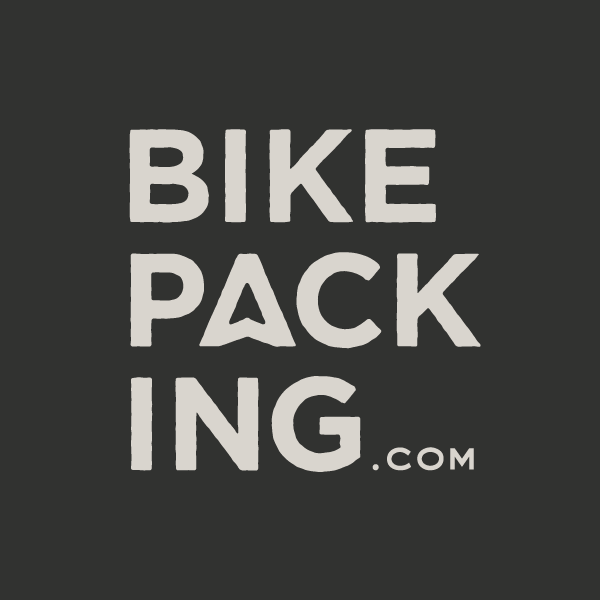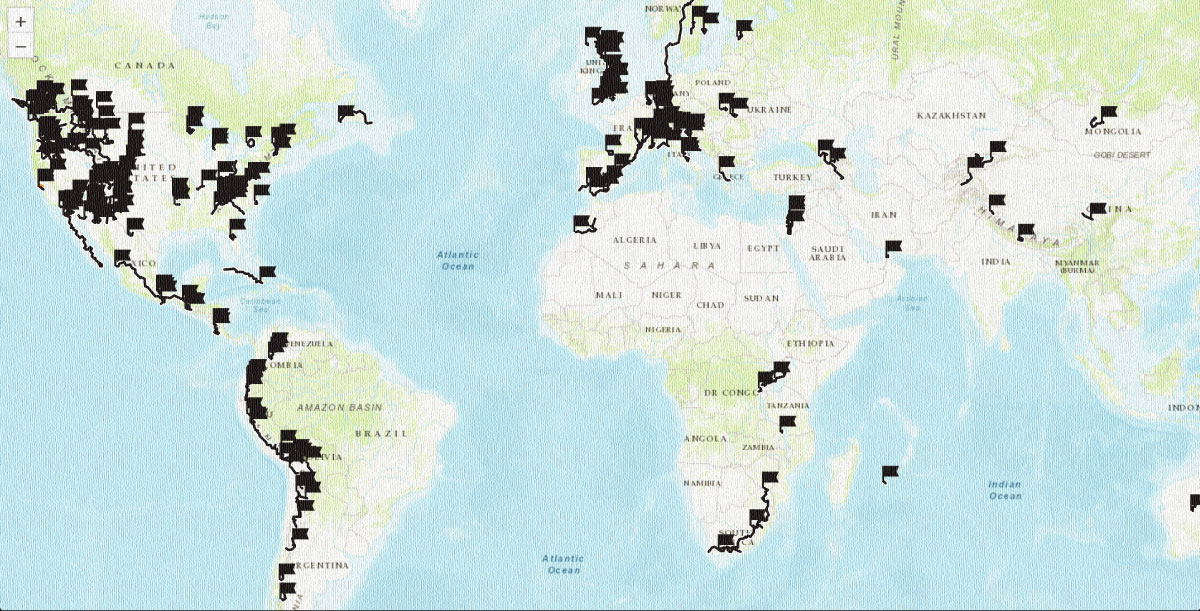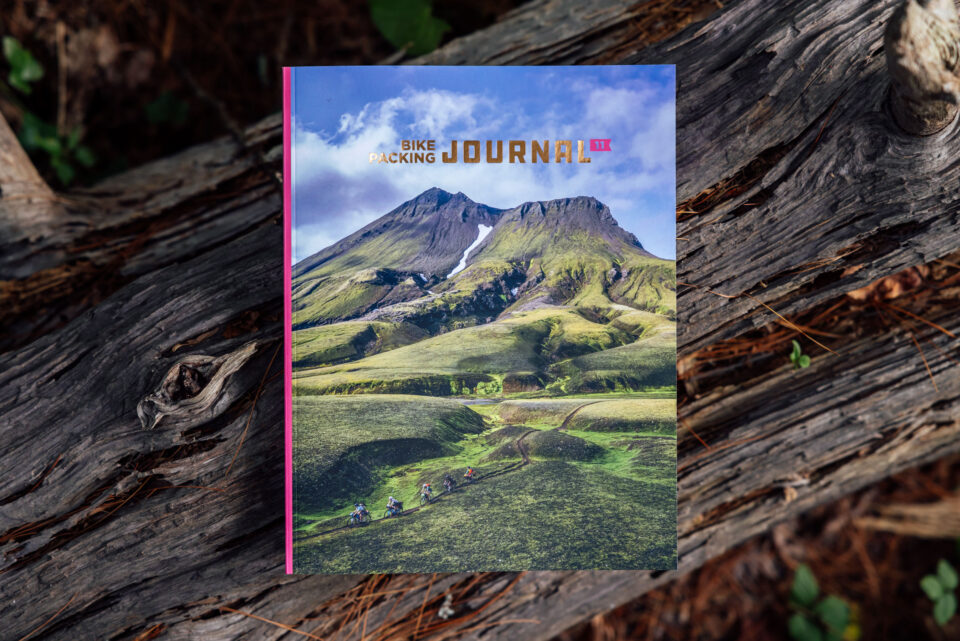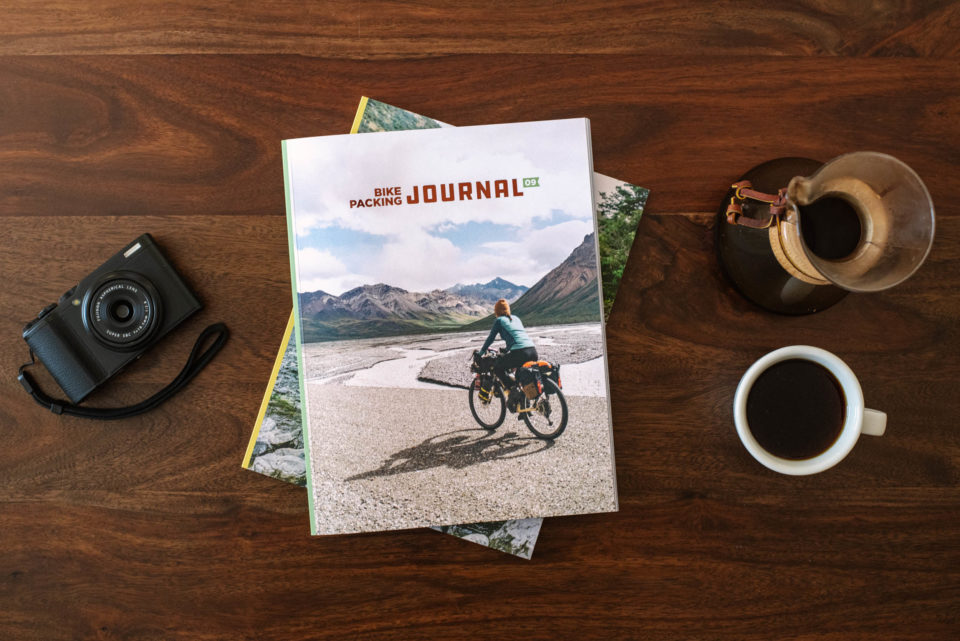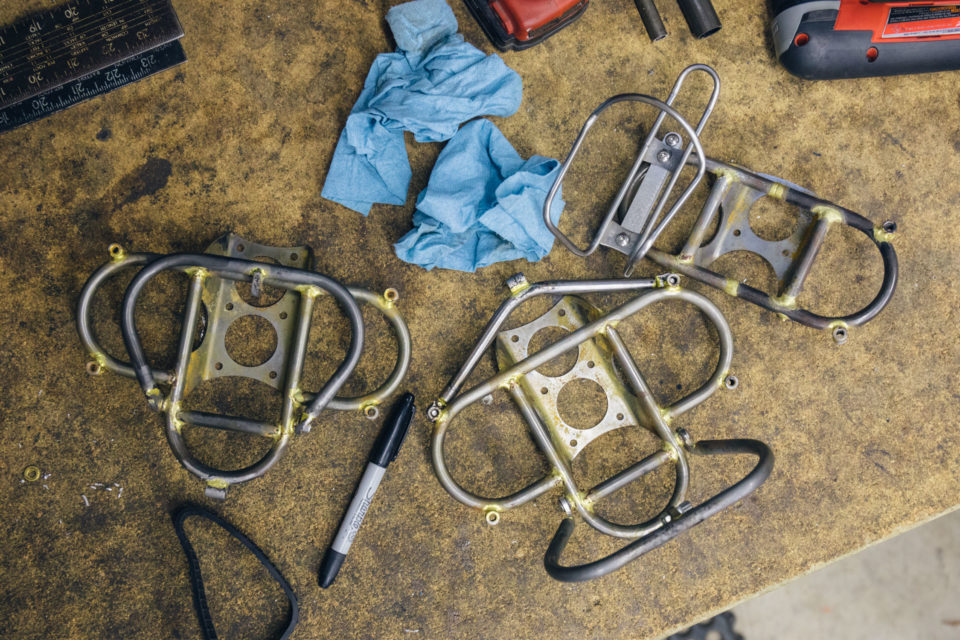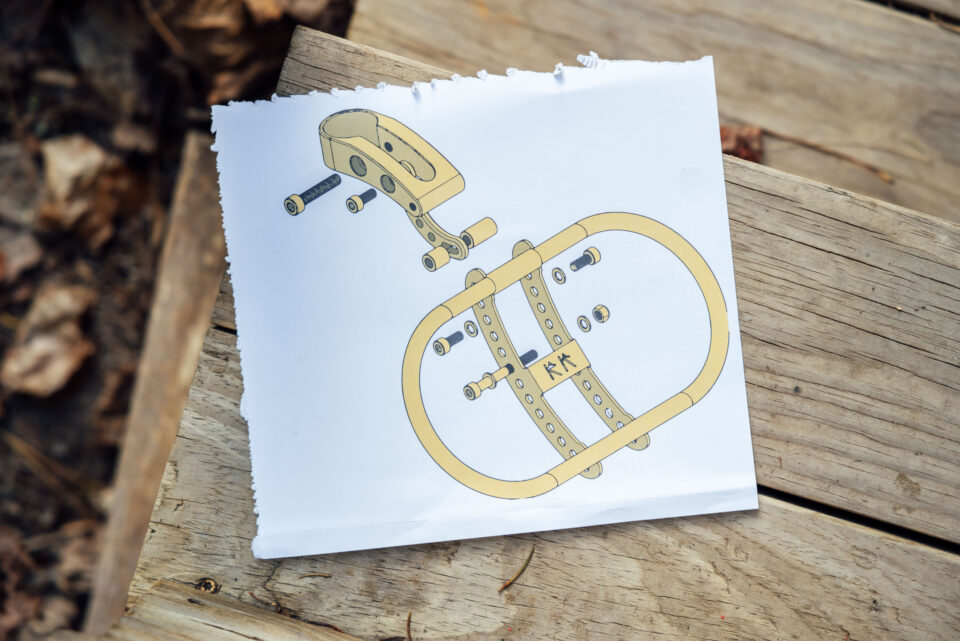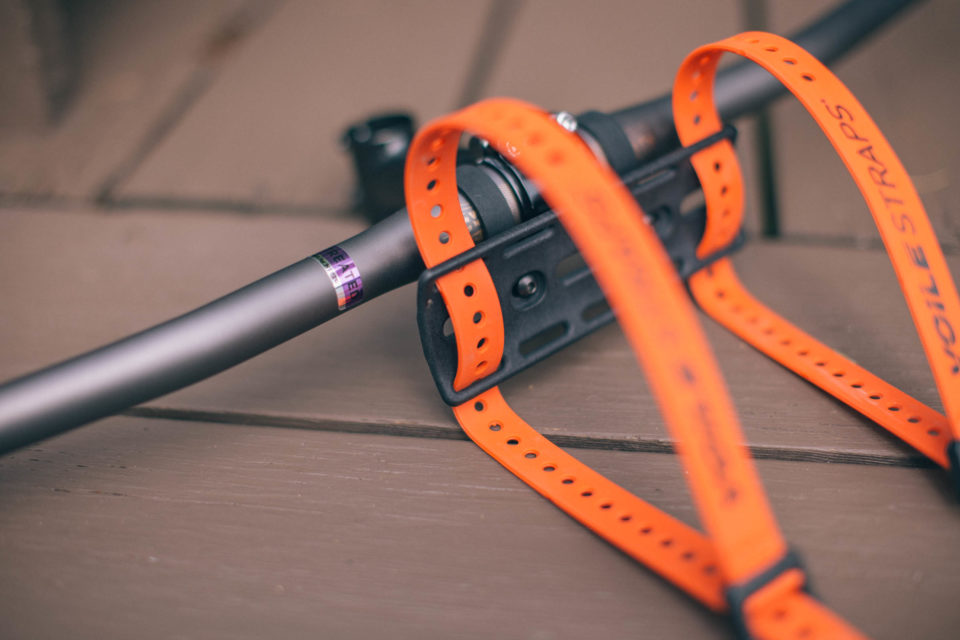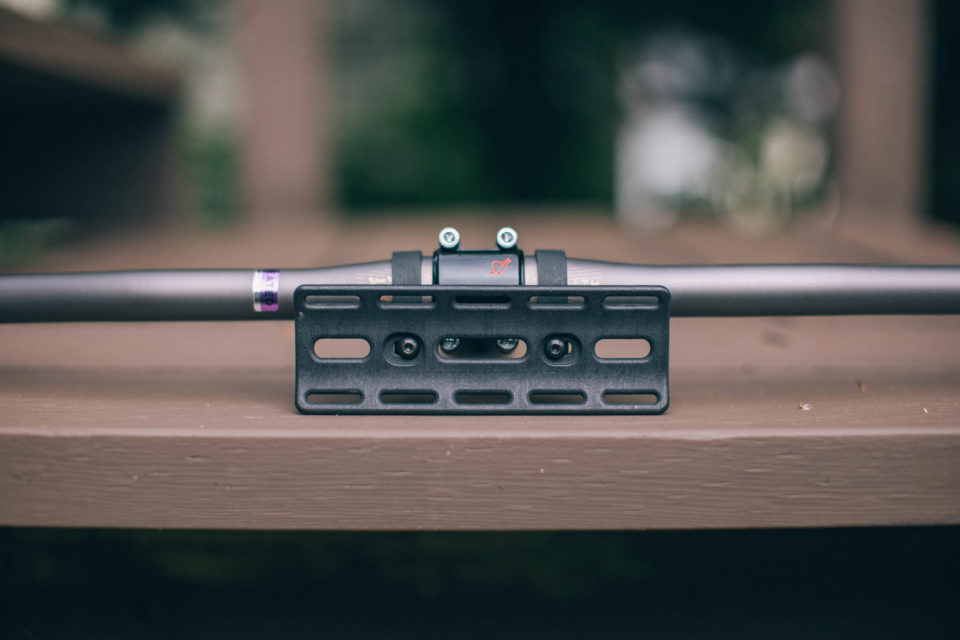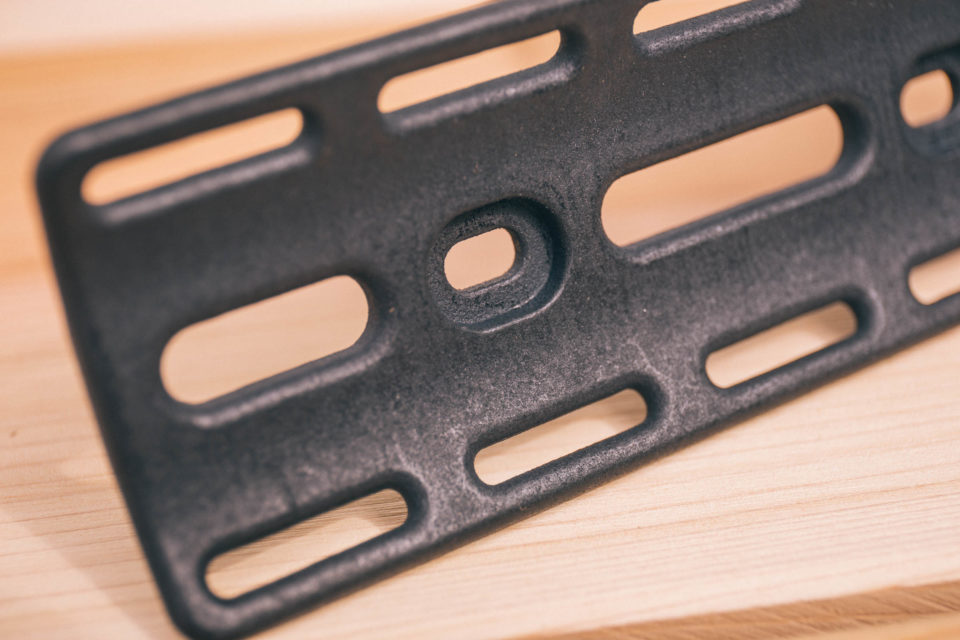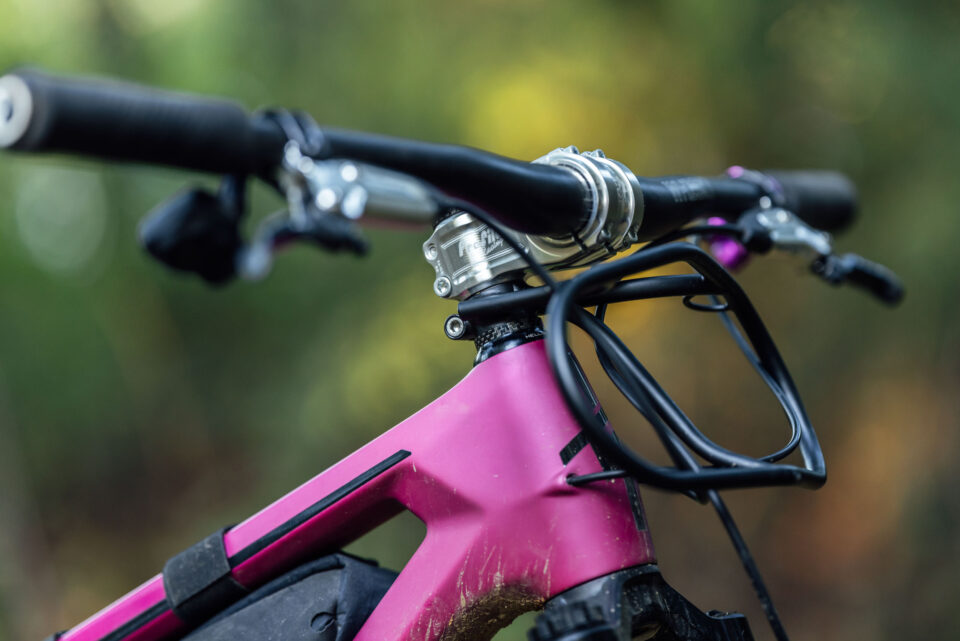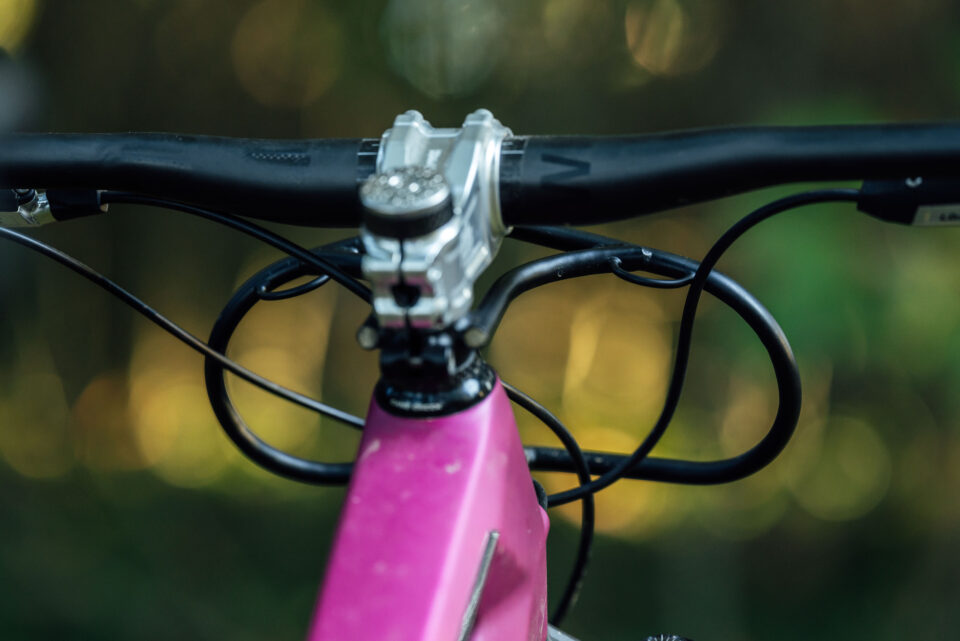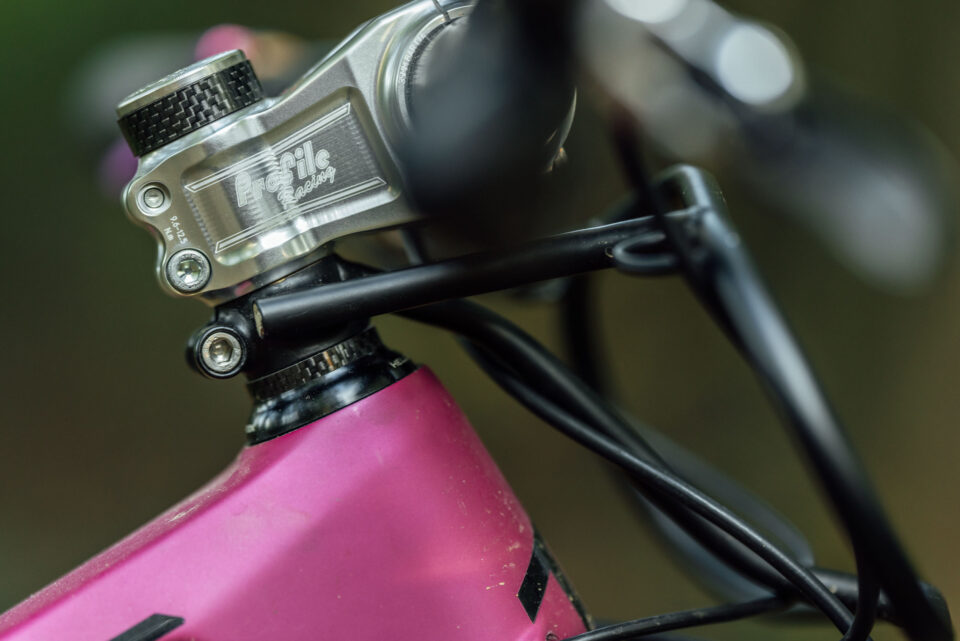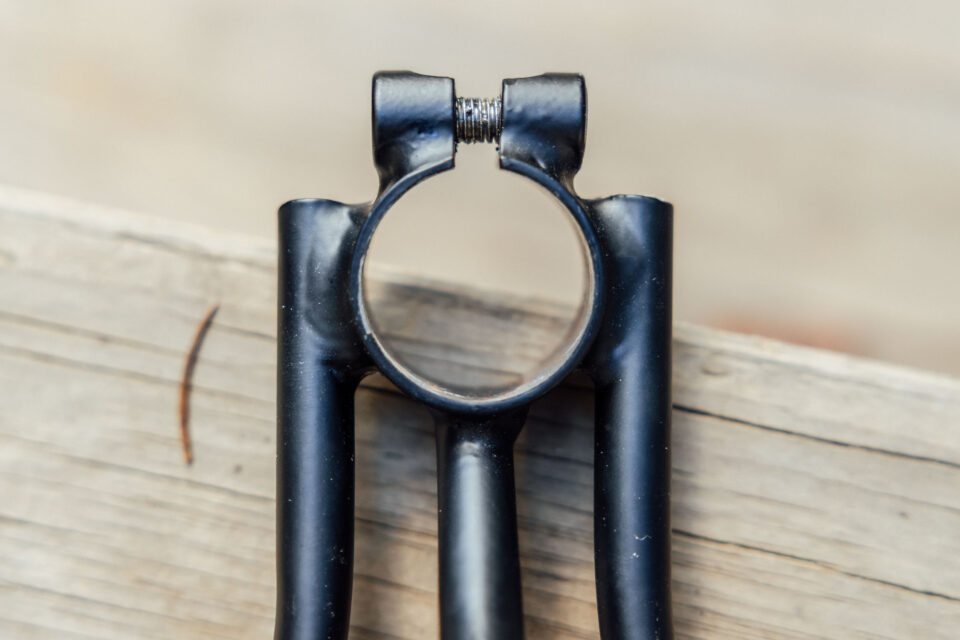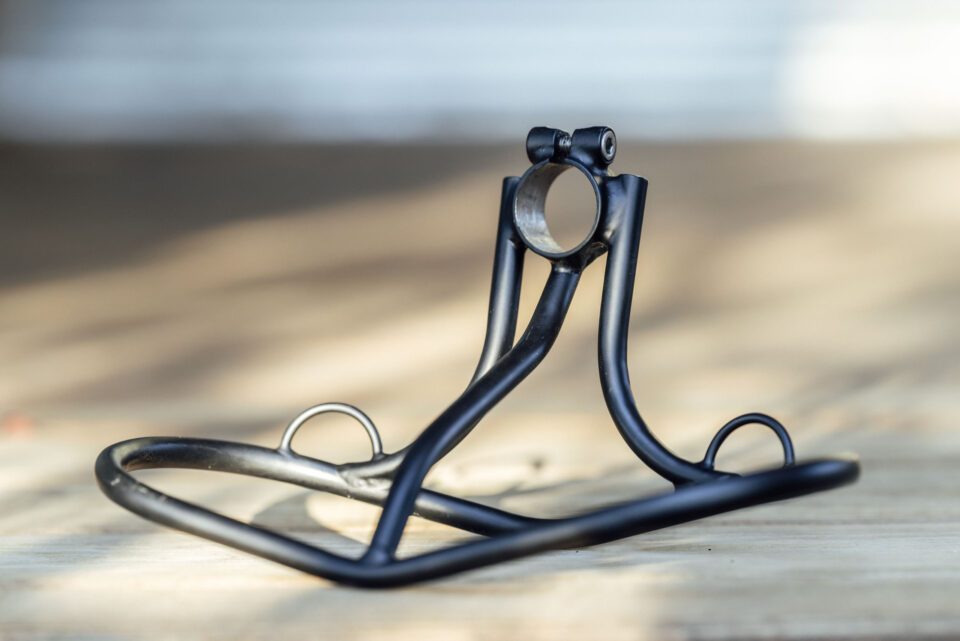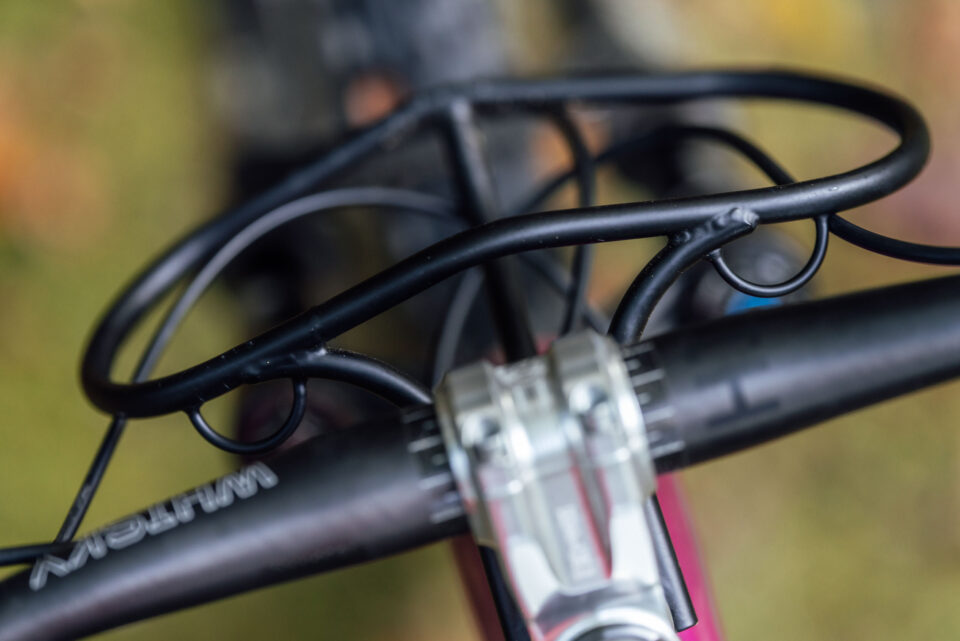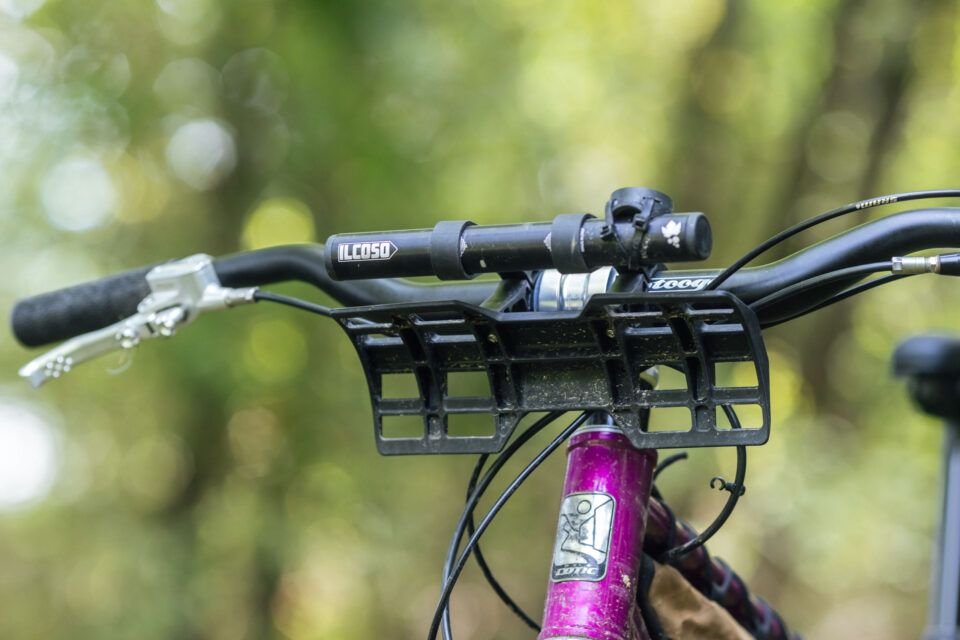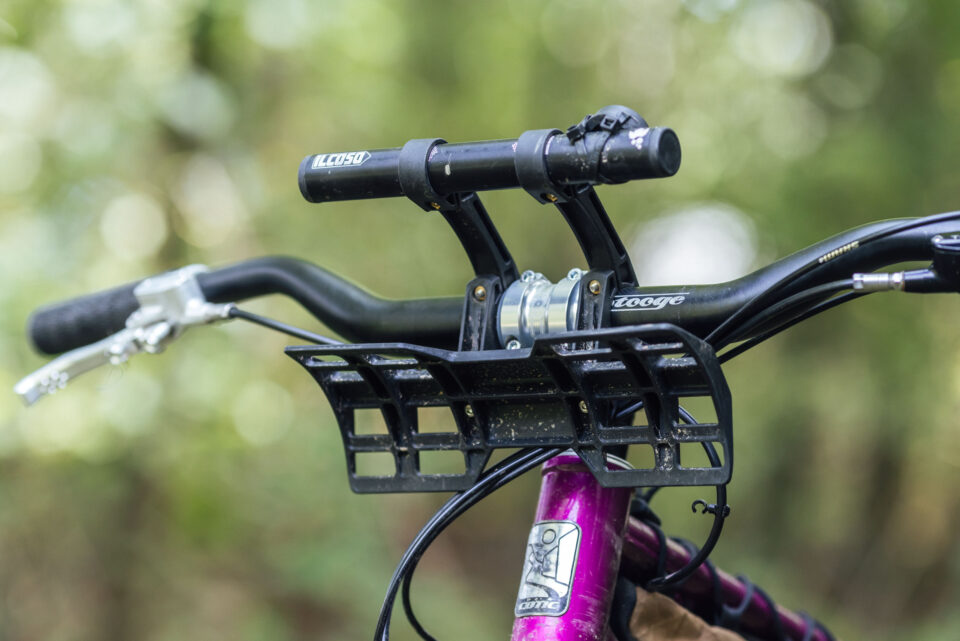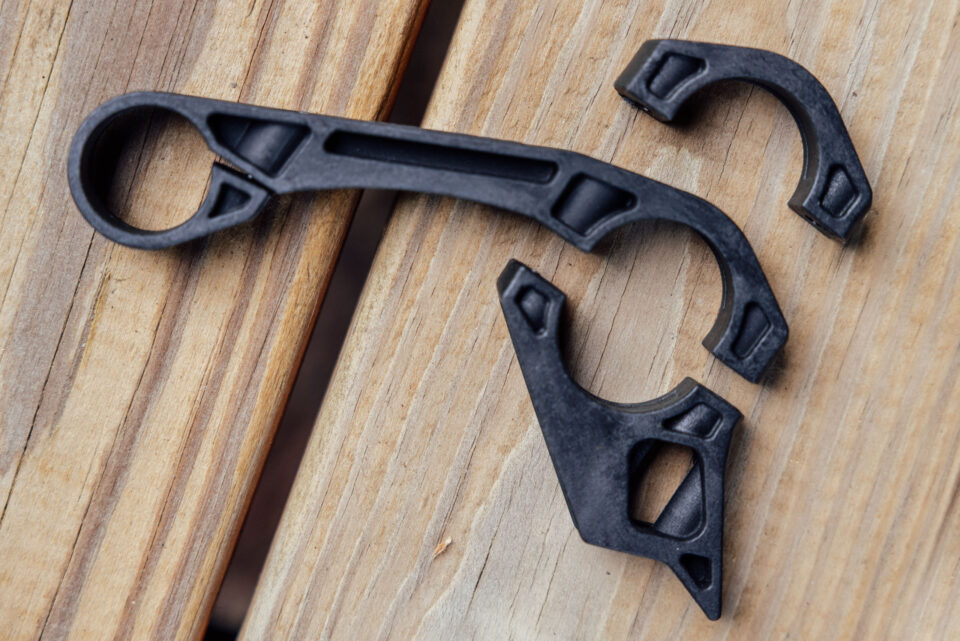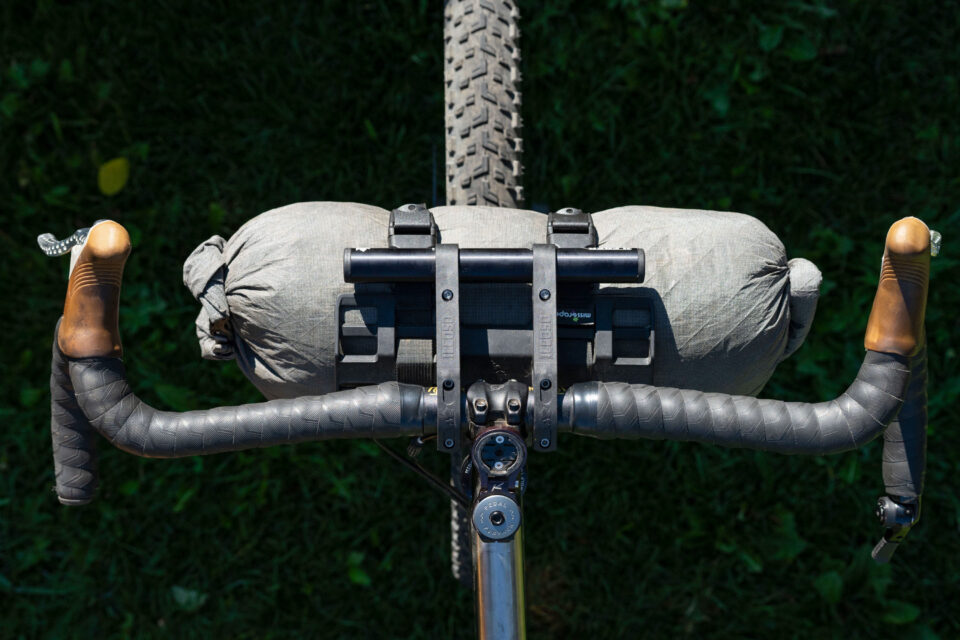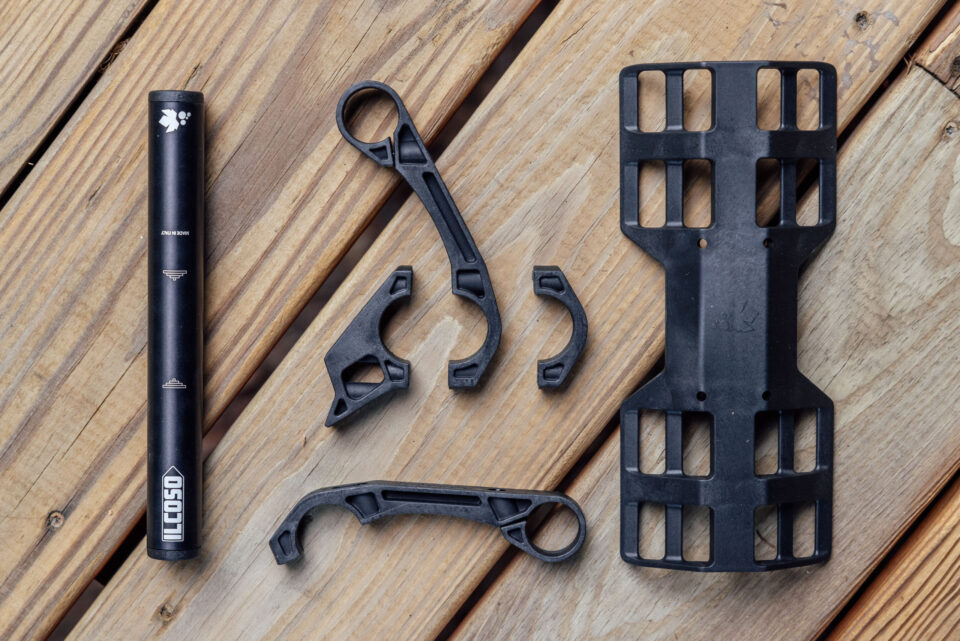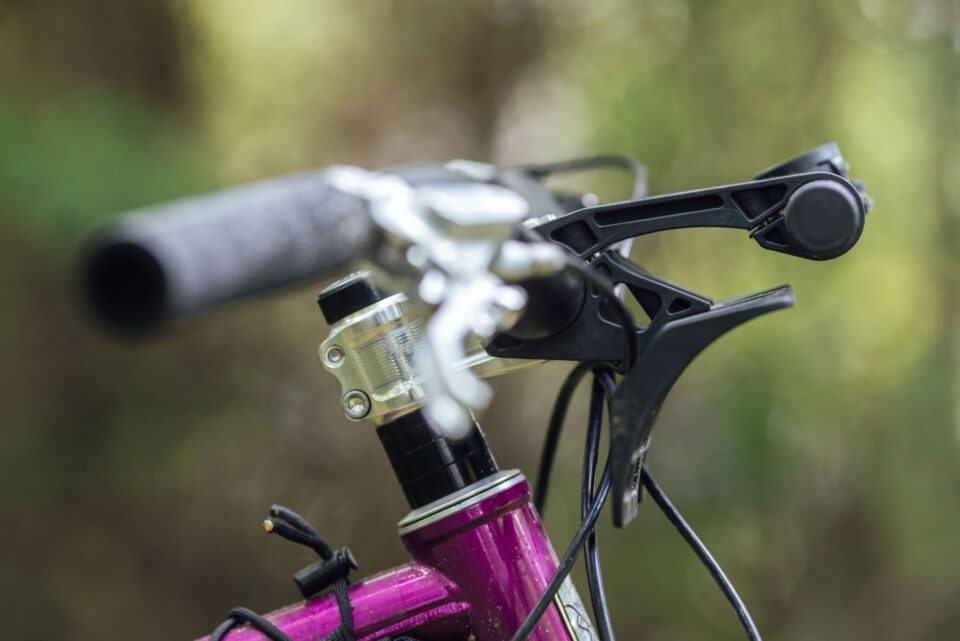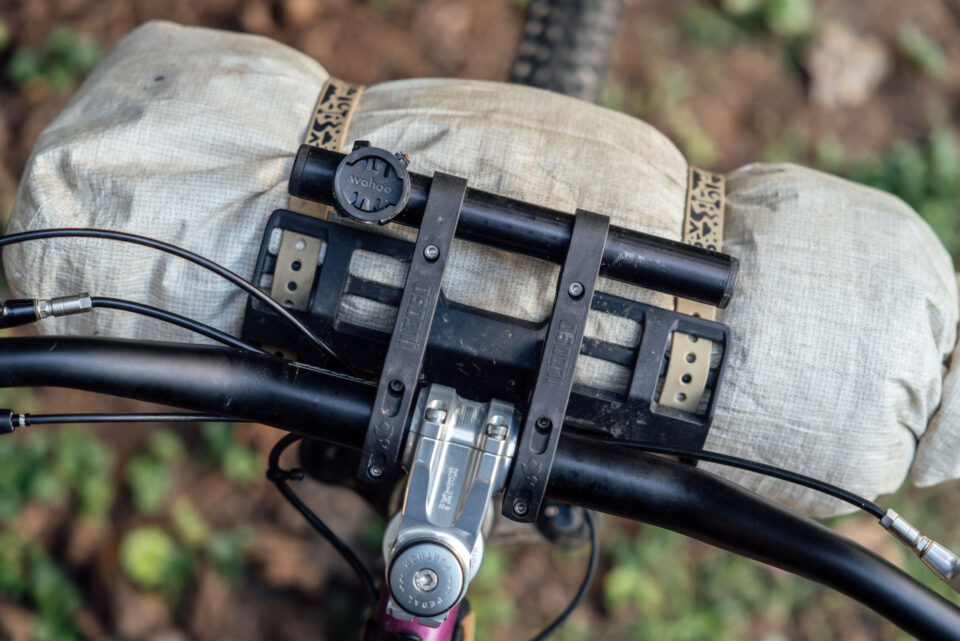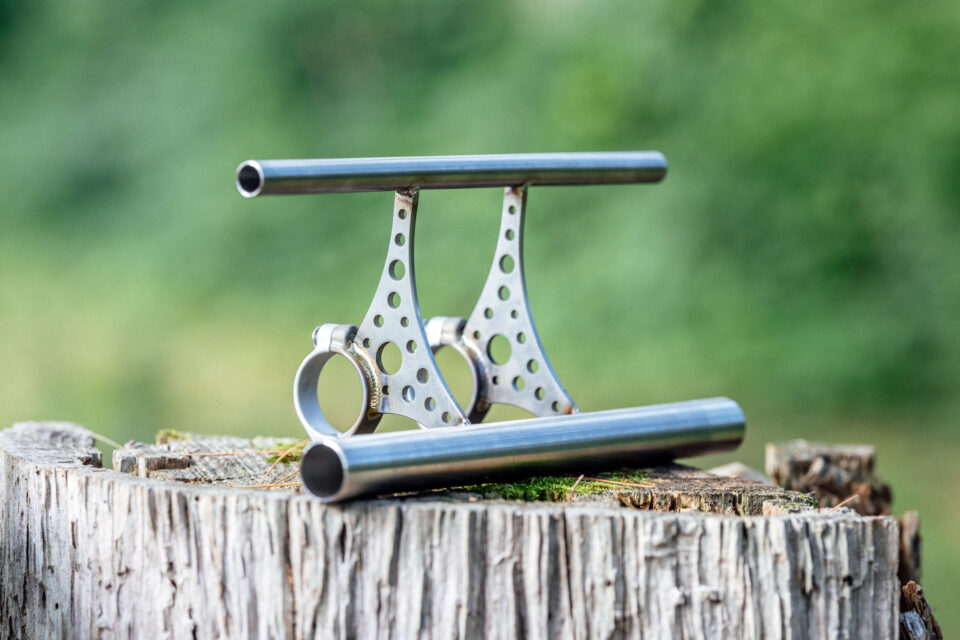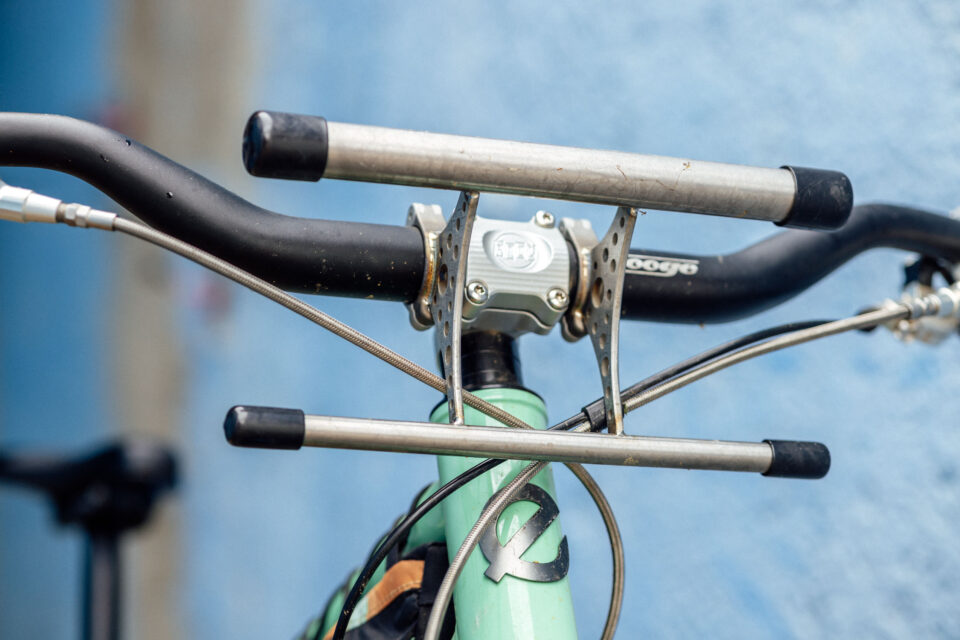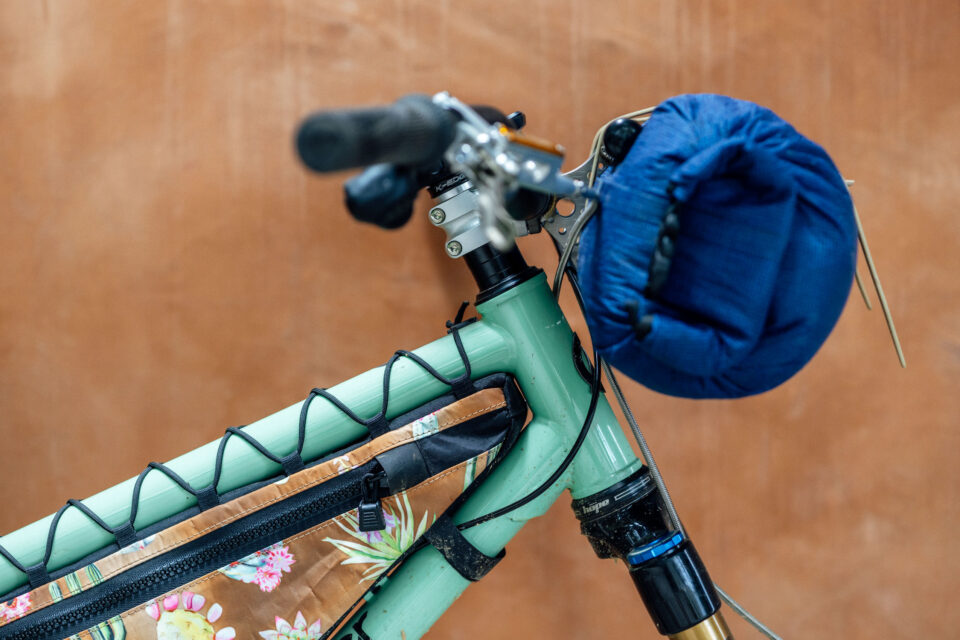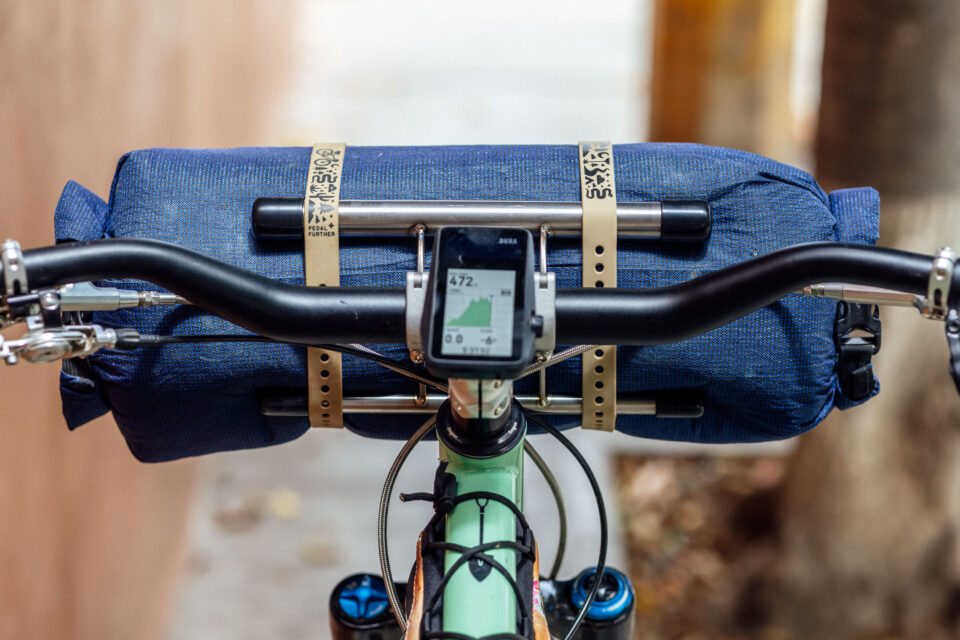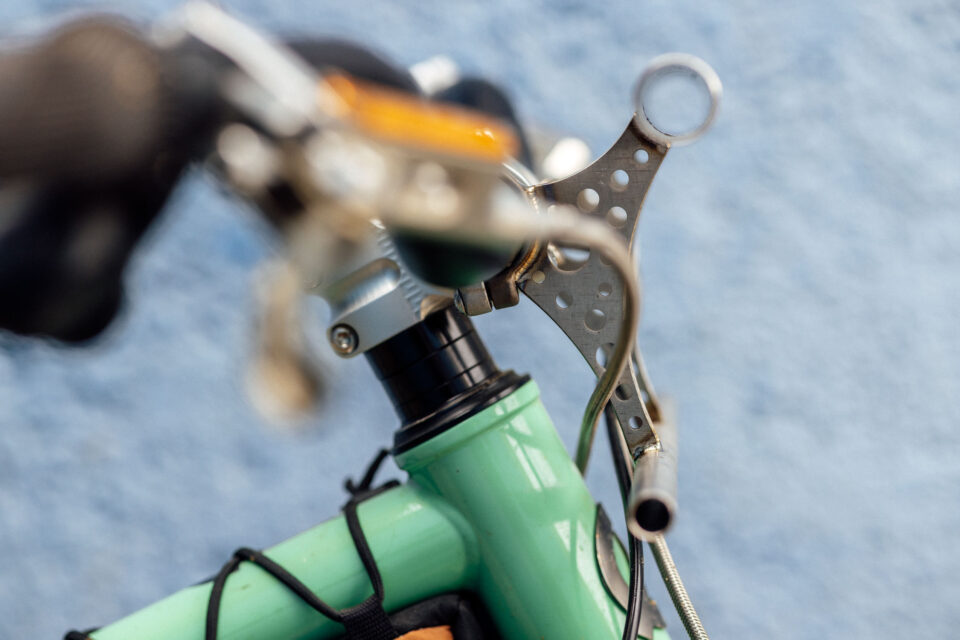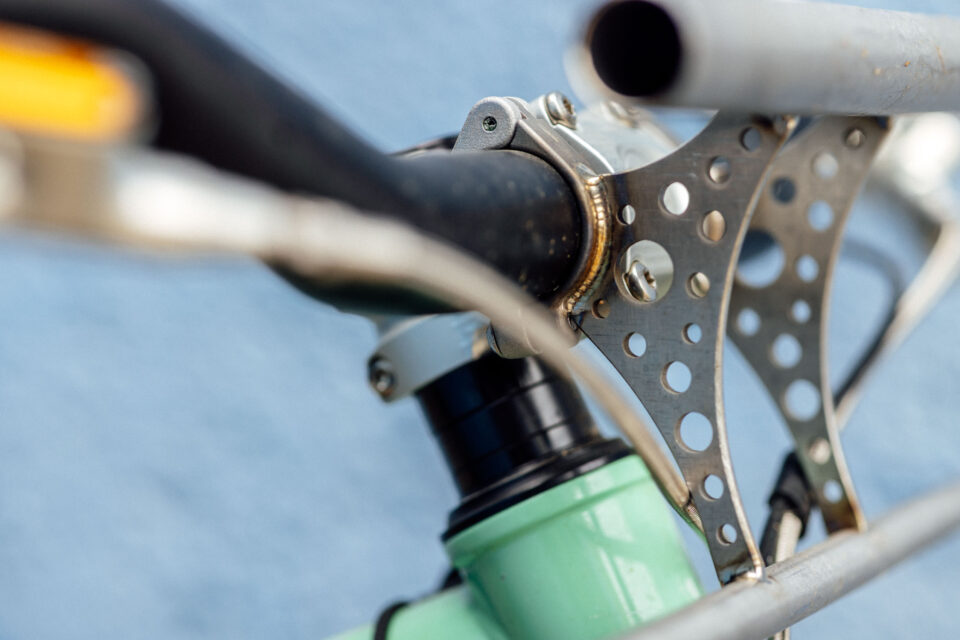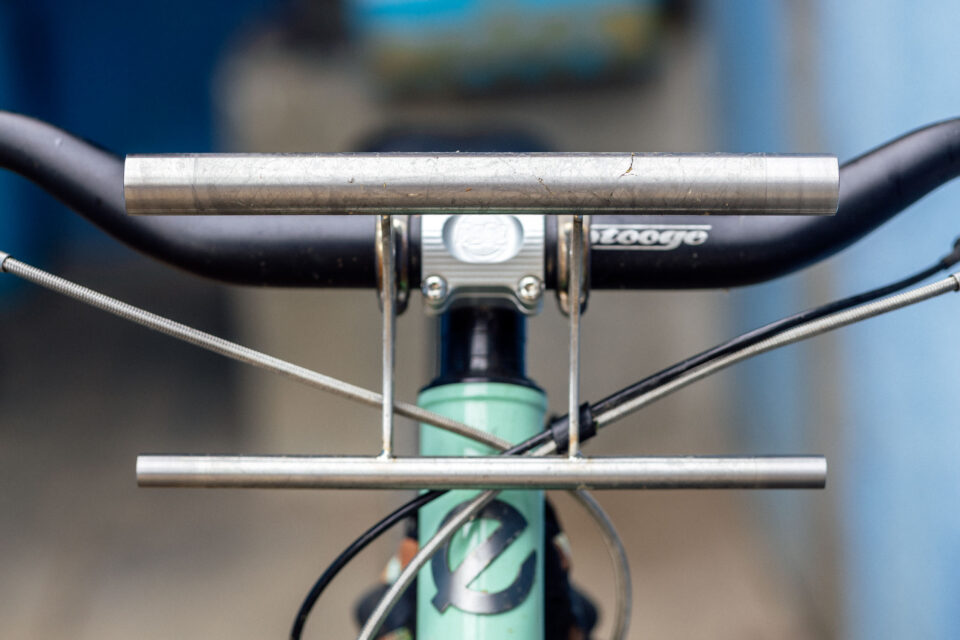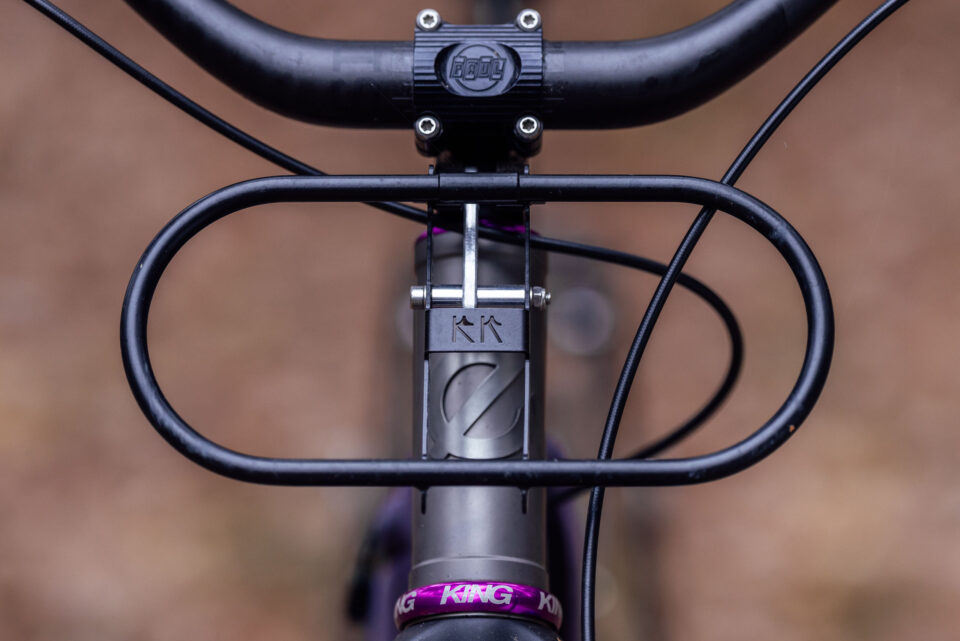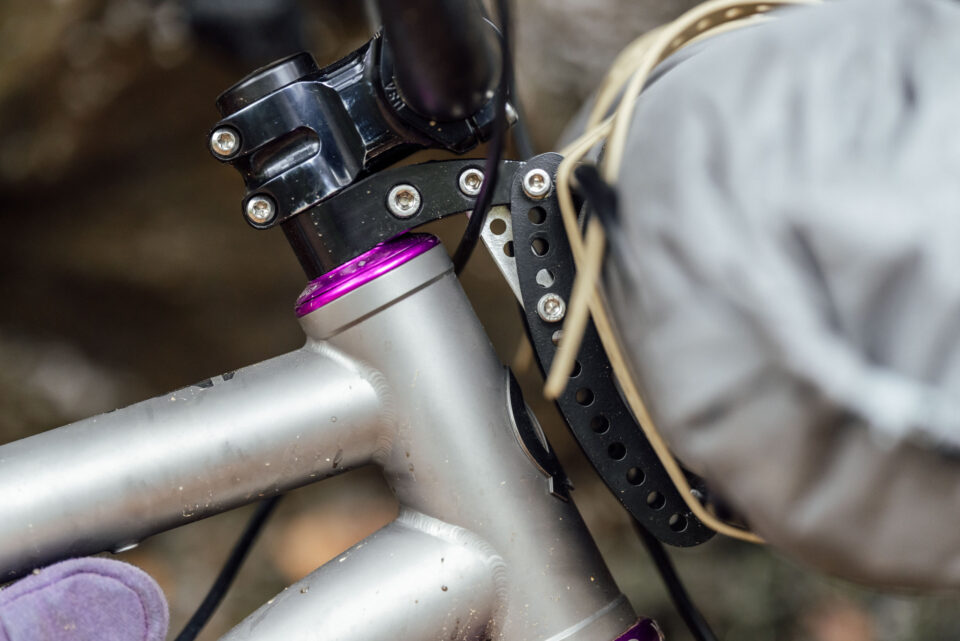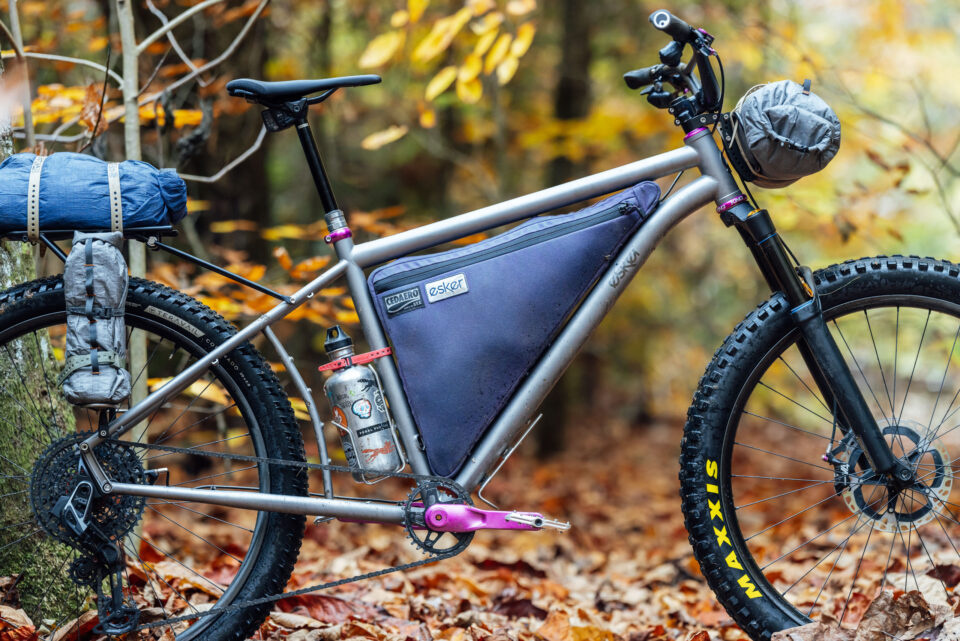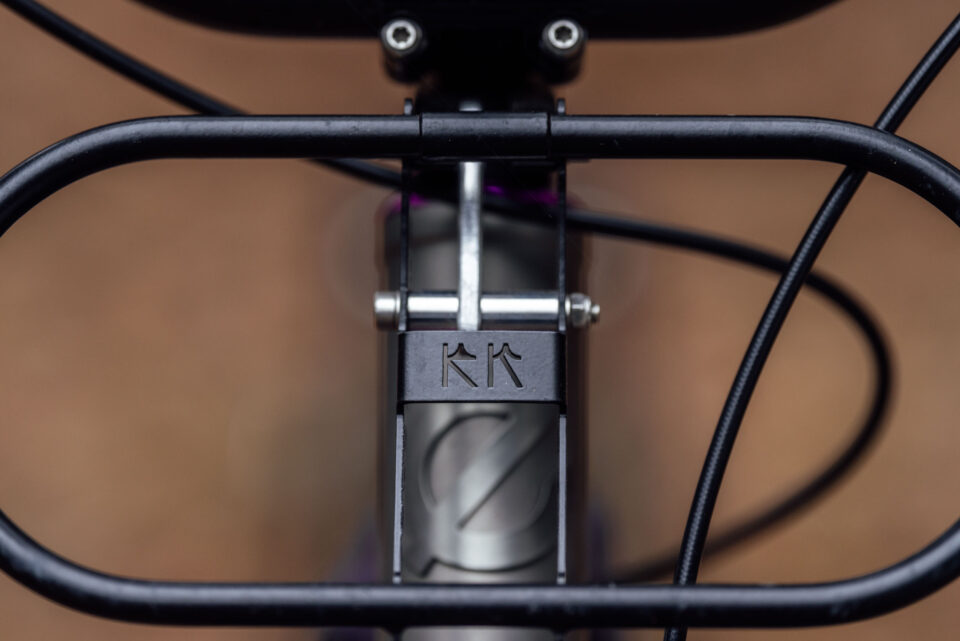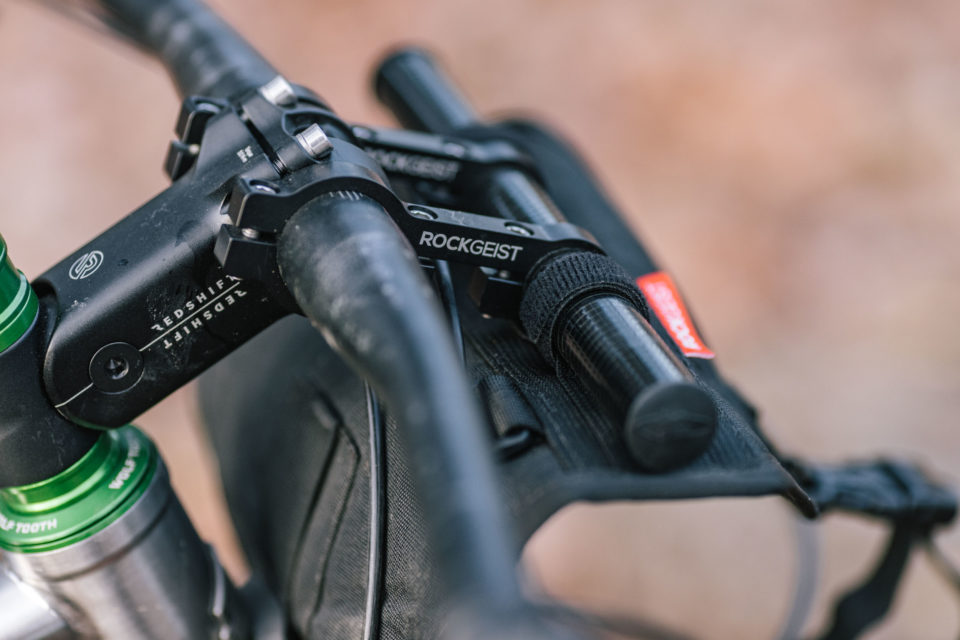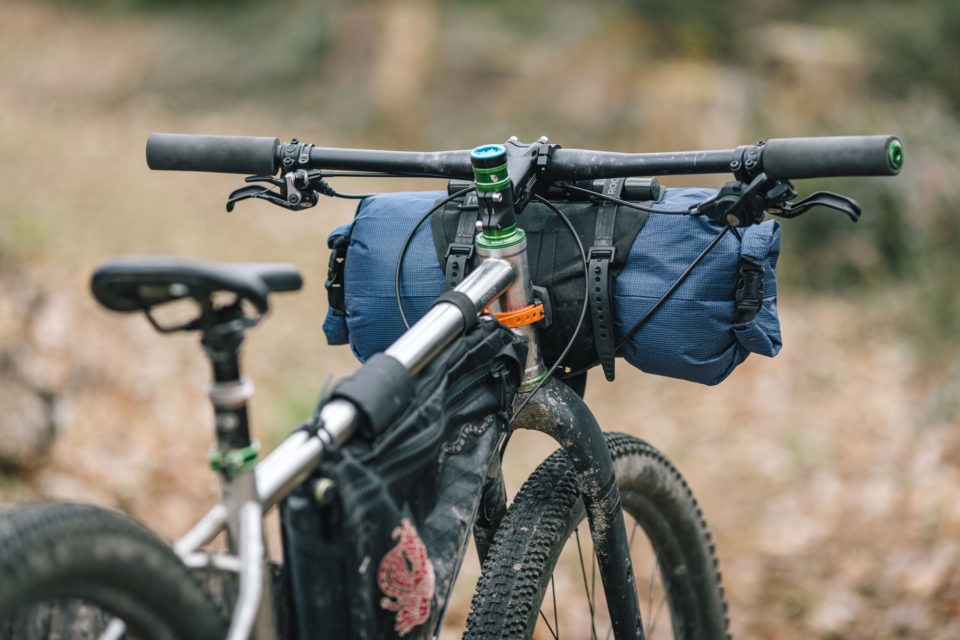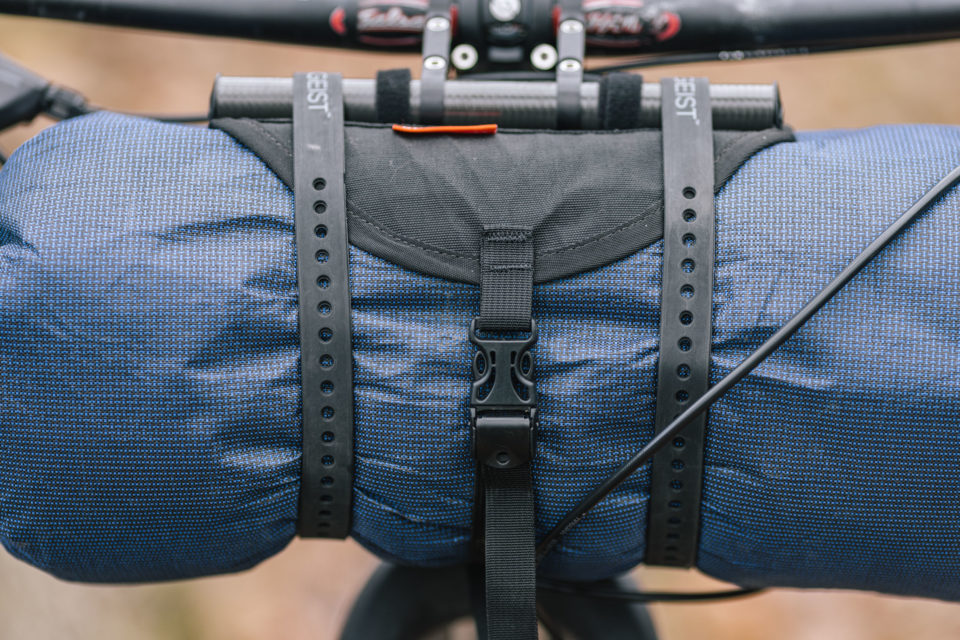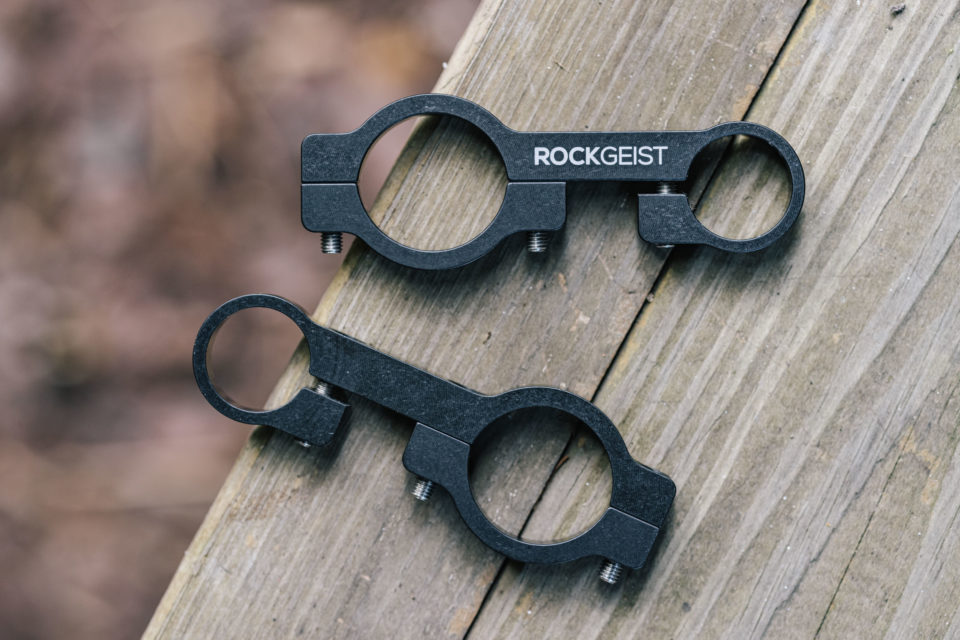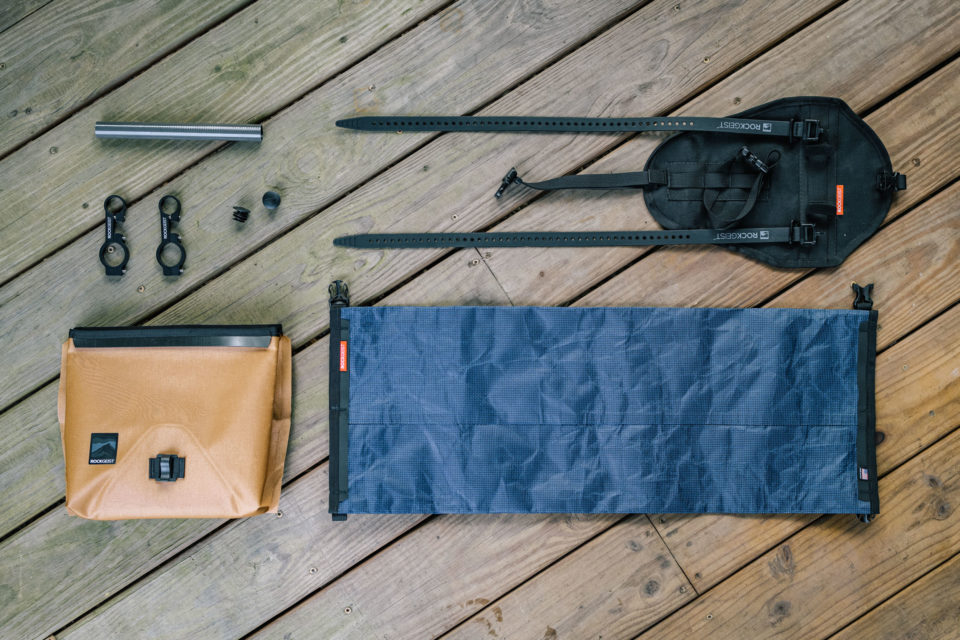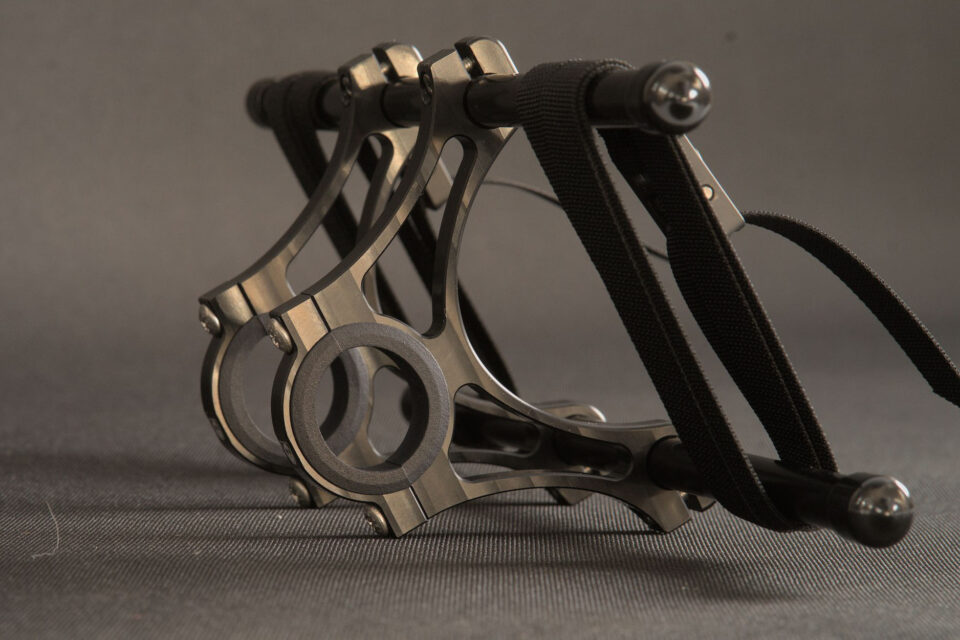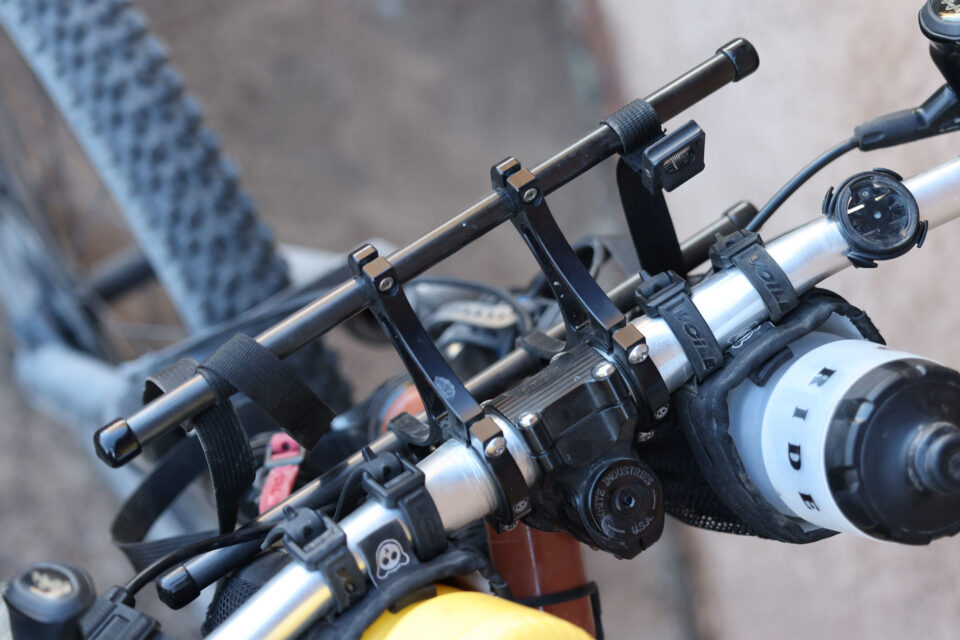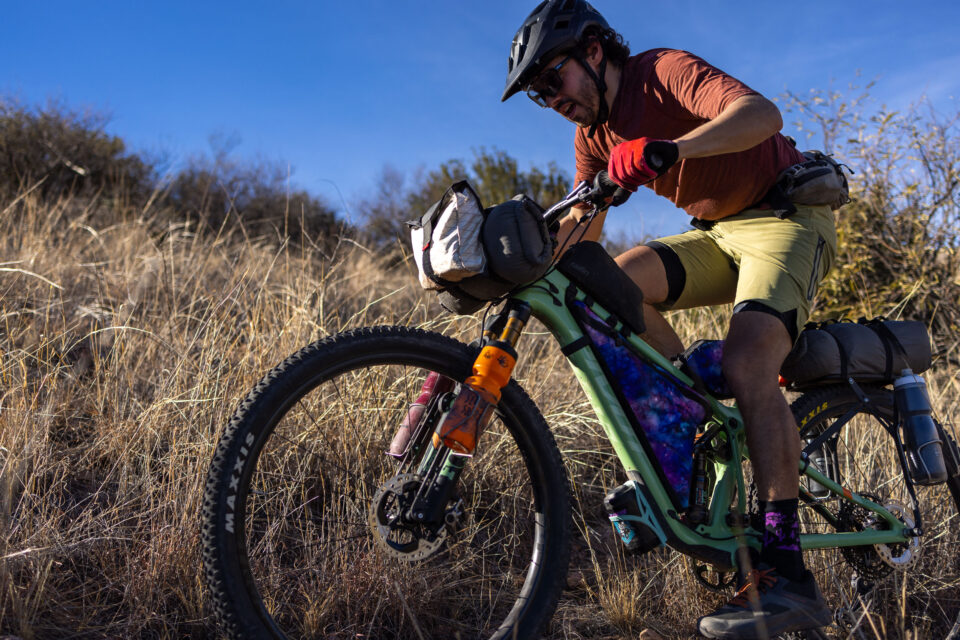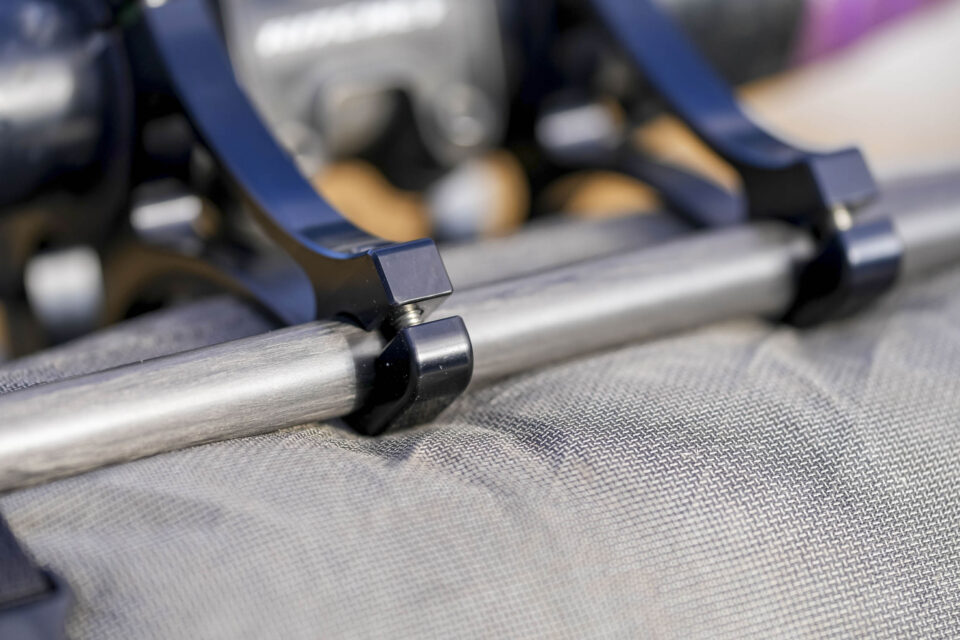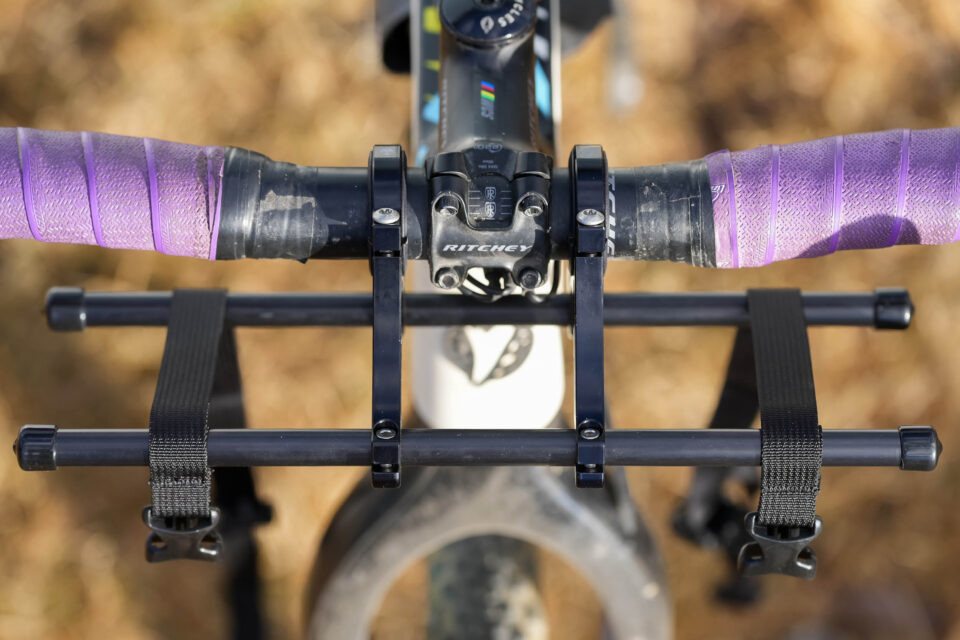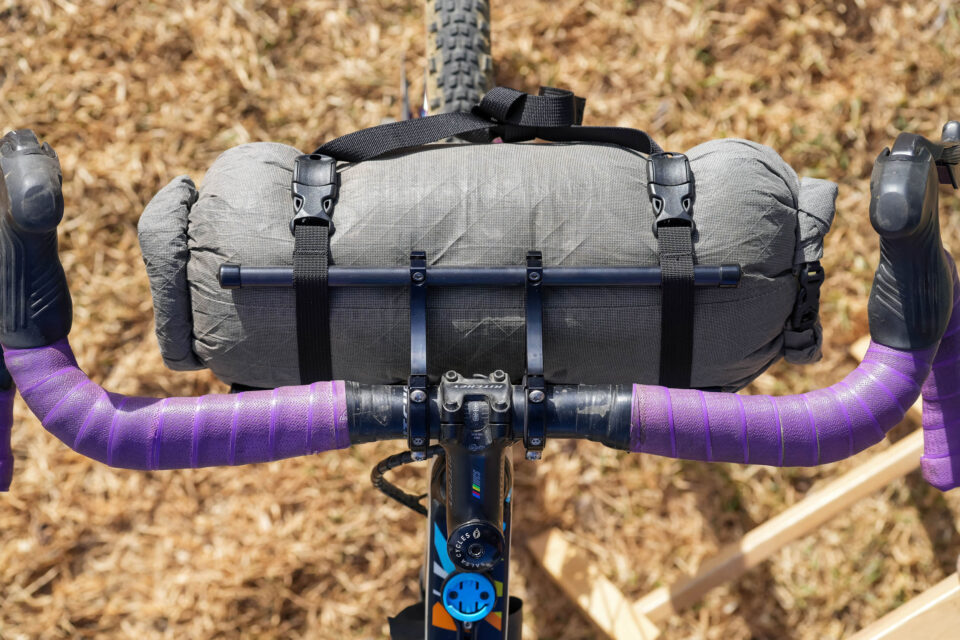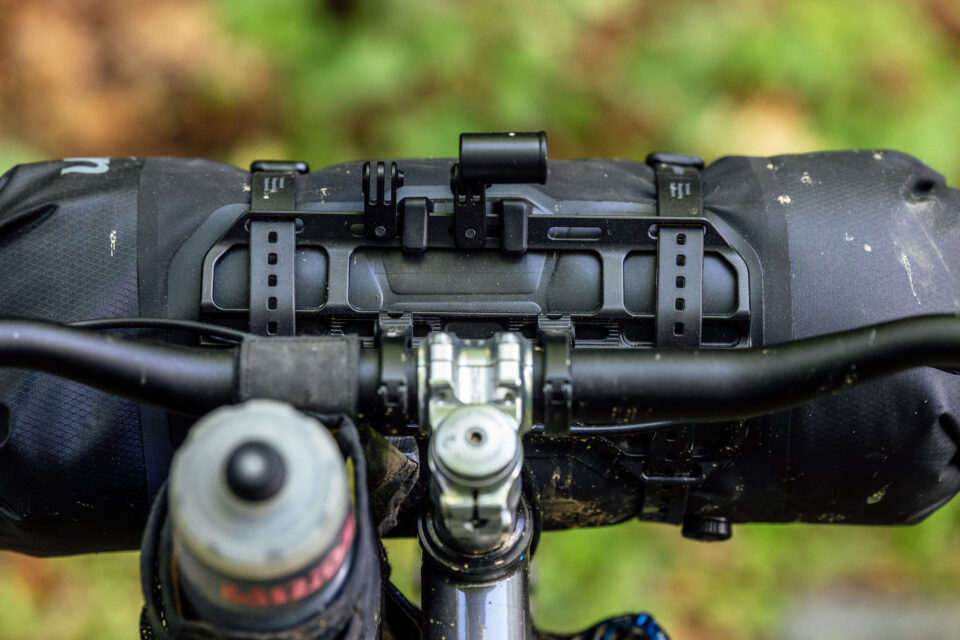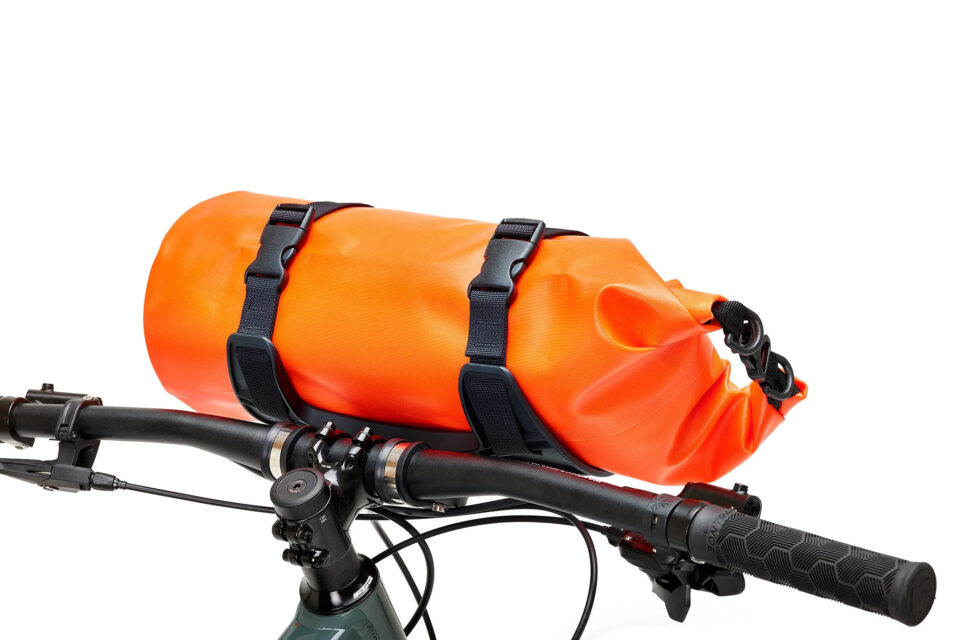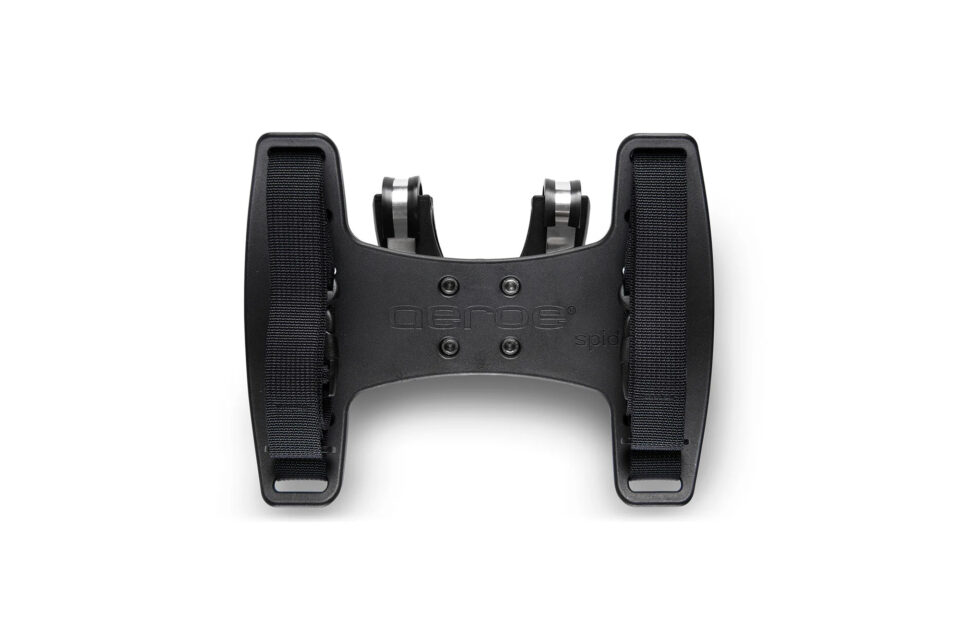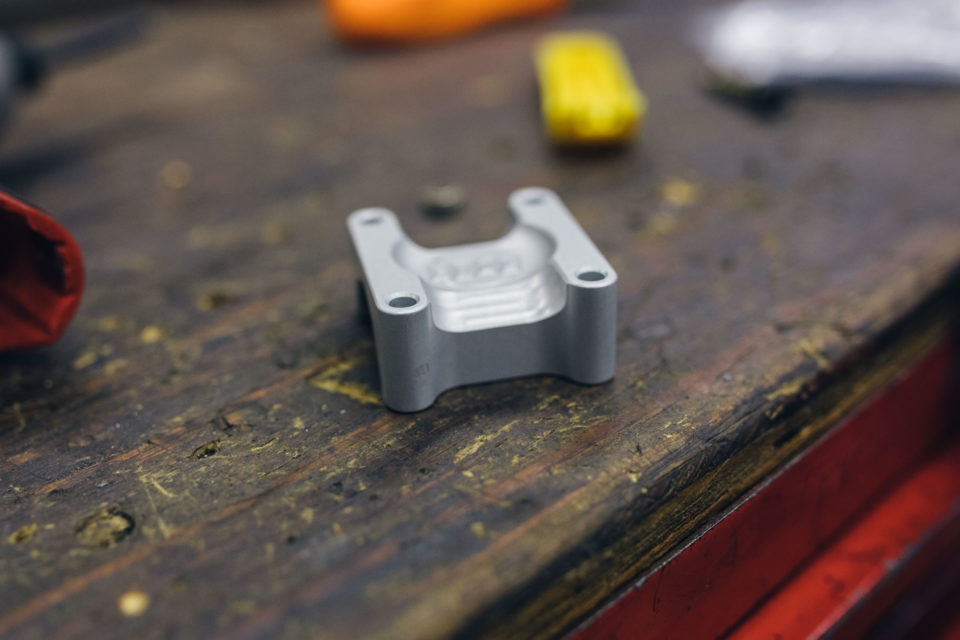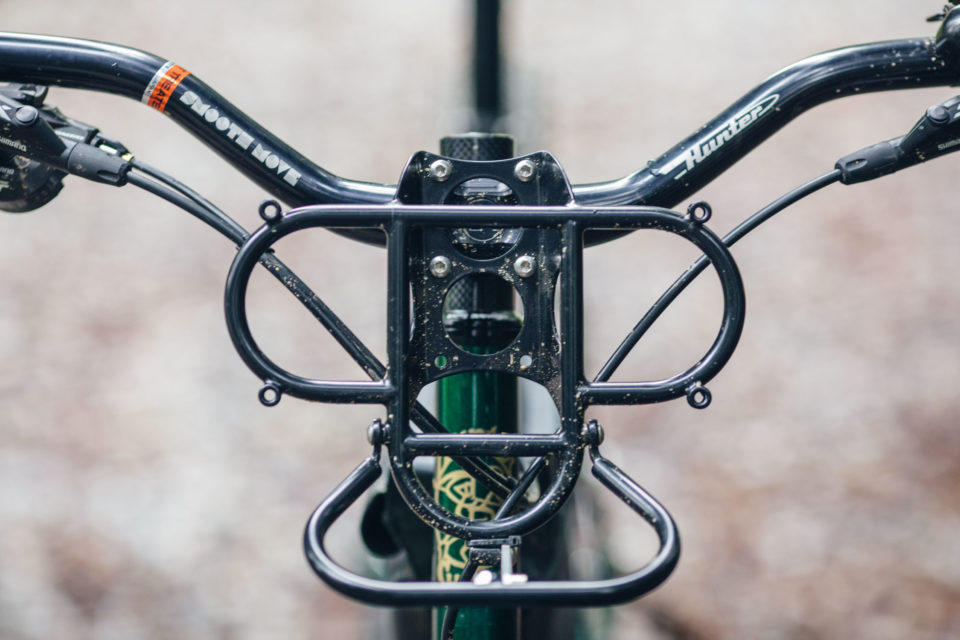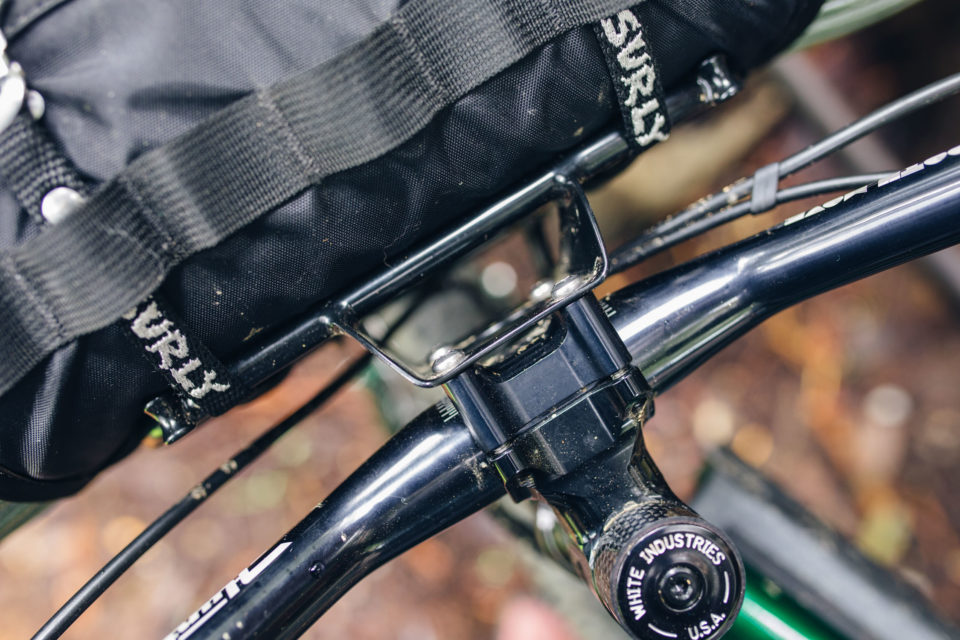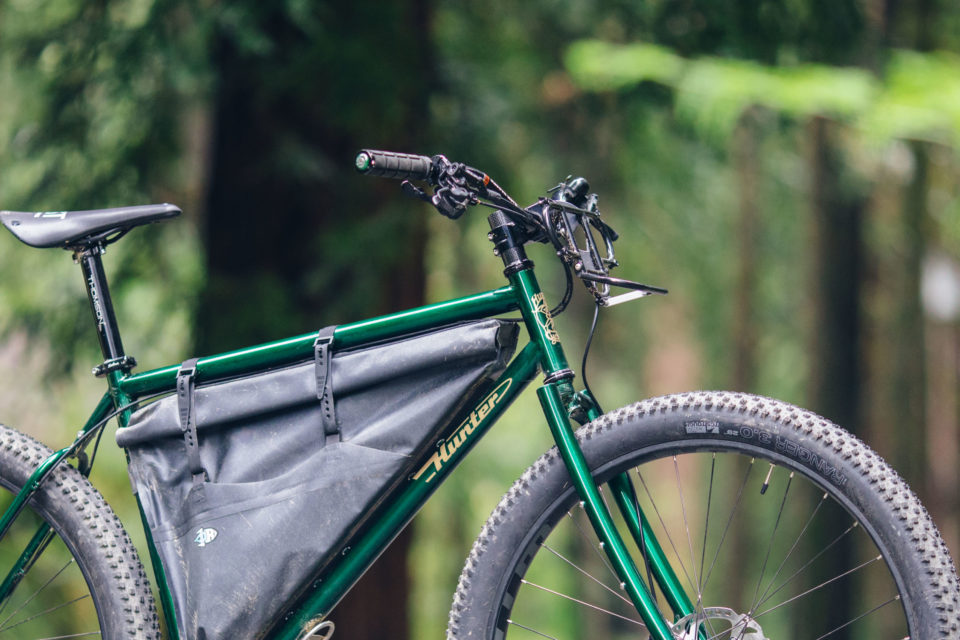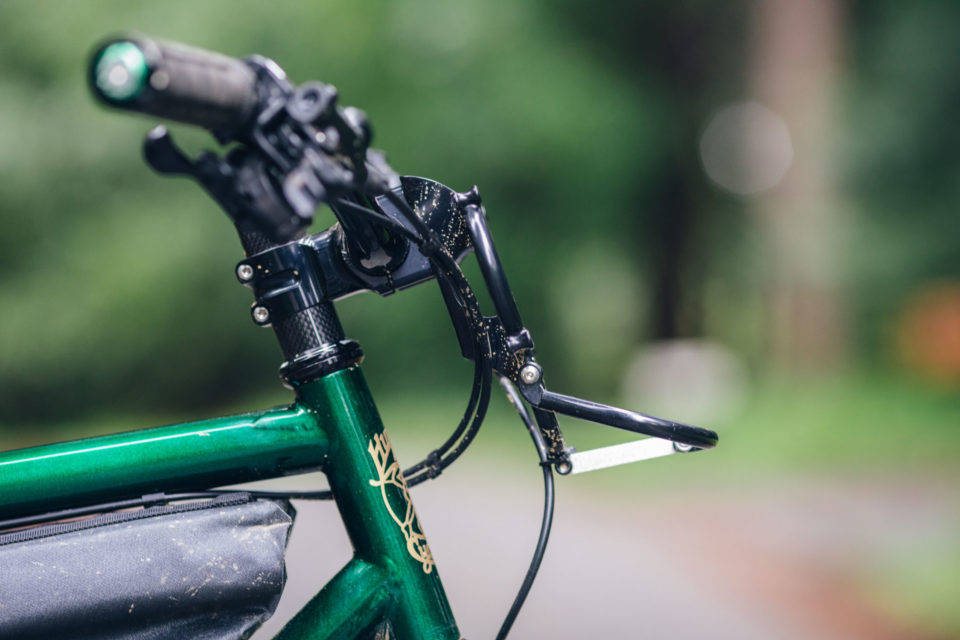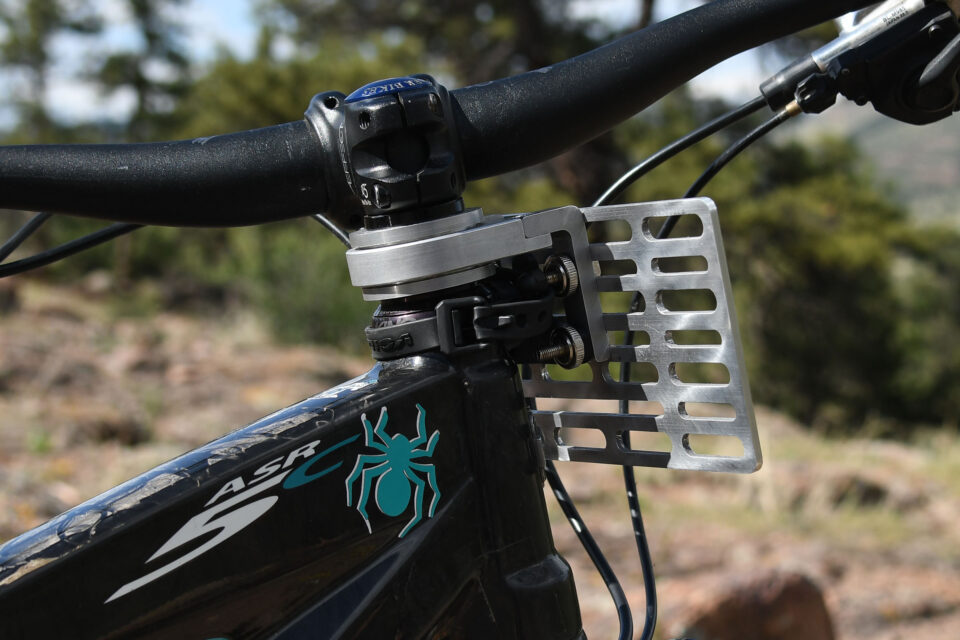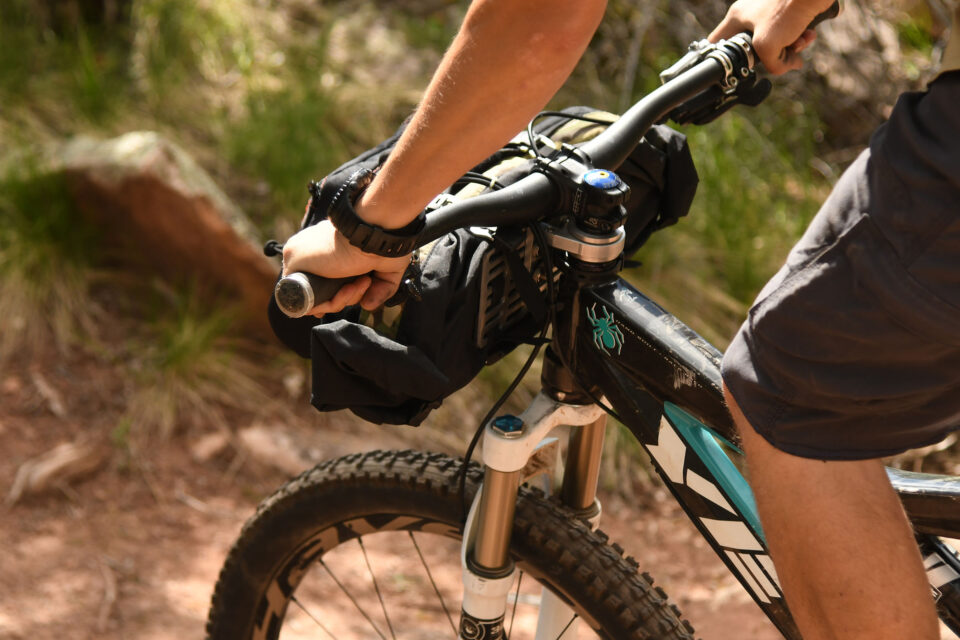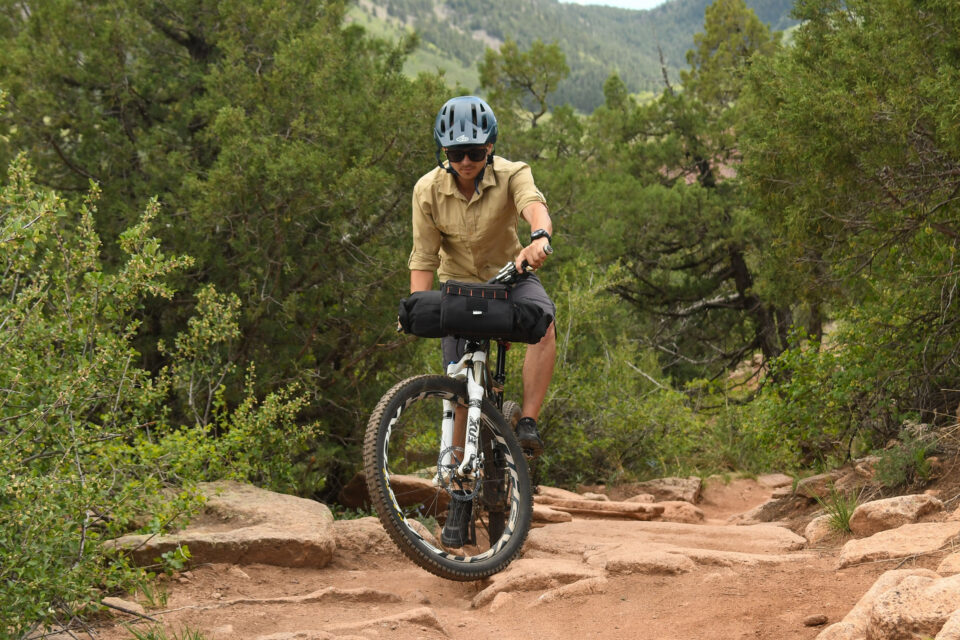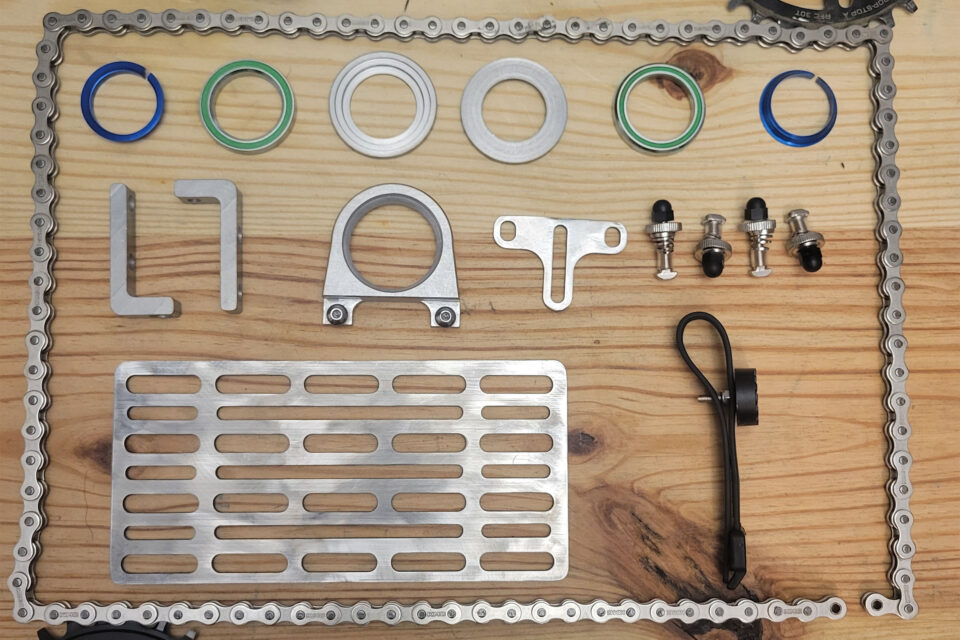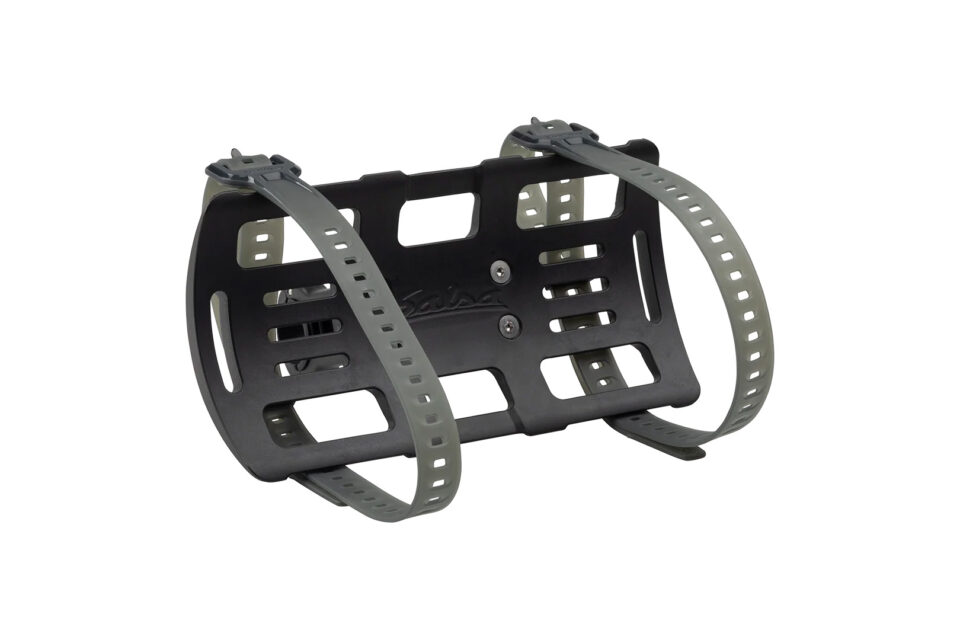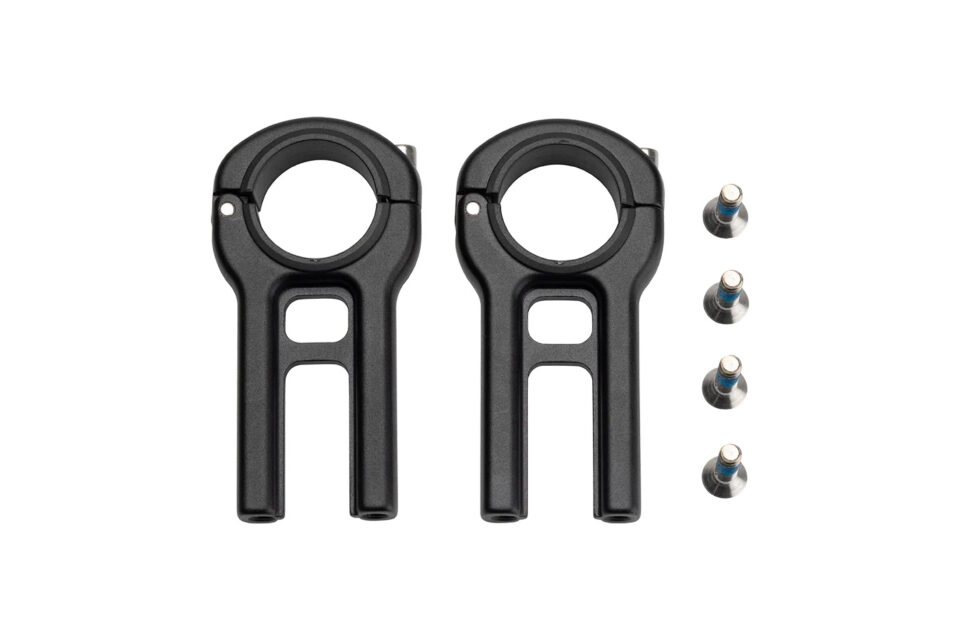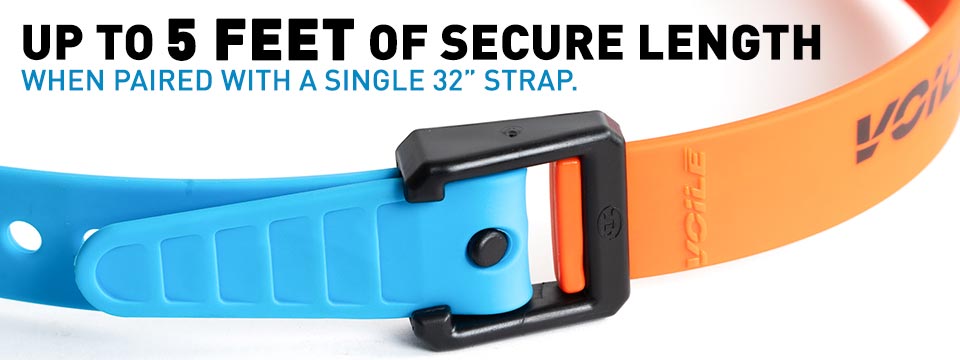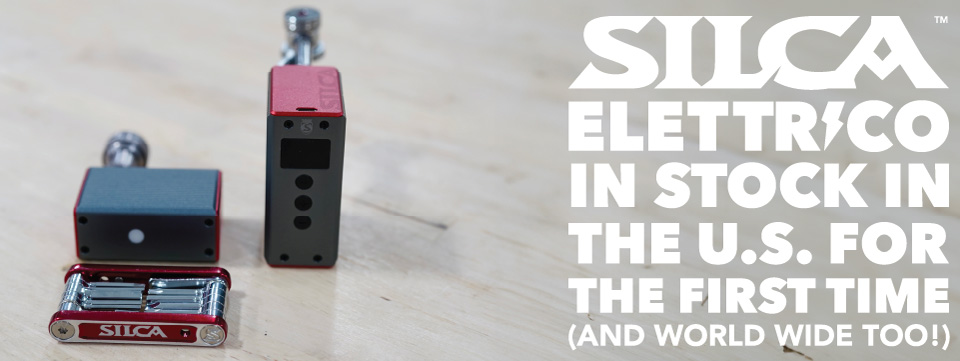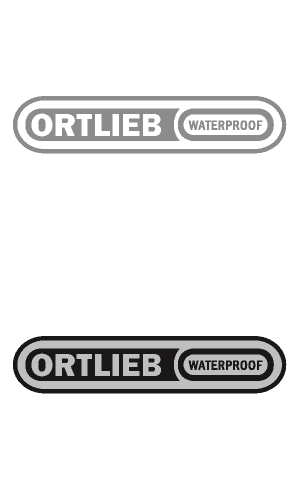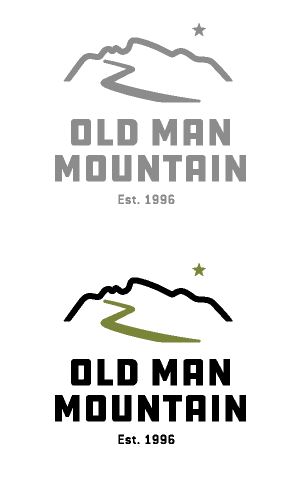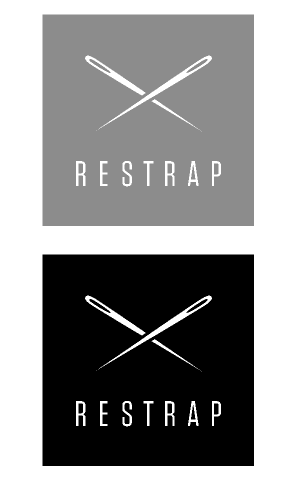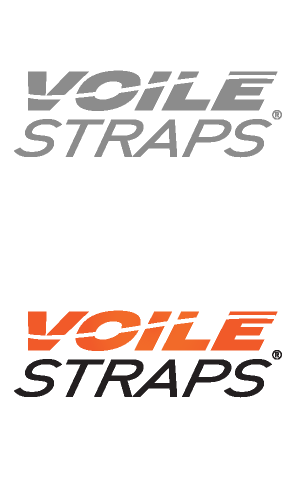PUBLISHED Sep 23, 2025
It’s dizzying to think about how many different methods and systems there are to carry stuff on a bike these days, especially when you consider the limited number of options we had just 12 or 13 years ago. Take handlebar bags, for example; way back in 2012 when I started this website, there were roughly three variations: smaller lunchbox-sized handlebar attachés (like the classic ORTLIEB Ultimate), “sausage roll” style soft bags (which were very new at the time), and top-opening Carradice saddlebags (that were repurposed for use on the bars). Thankfully, countless bag makers and tinkerers have been hard at work improving these systems and figuring out new ones. A fruit of all these labors is a relatively new subcategory: handlebar cradles.
If you’ve bikepacked with a handlebar roll or top-opening bag, you know the headaches: straps that rub paint—or even carbon—and constant interference with brake and shift cables. On top of that, many strap systems hog bar space, collide with other bags, and crowd out lights or accessories you’d rather mount up front. To solve this, handlebar-mounted mini-racks make a great alternative—a fixed cradle that secures a removable roll-top bag while keeping it clear of cables and controls. To me, this hits a sweet spot: minimalist and tidy, yet functional enough to keep gear stable without the weight, hardware, or complexity of a full rack. It’s a concept many of us on the team have rooted for—and have frankly wished was more popular. Options have been thin until recently, however, with only a handful of products on the market. This is surprising considering the O.G. Salsa Anything Cradle was released in 2016. It took nine years to finally have enough to warrant a Gear Index on the subject.
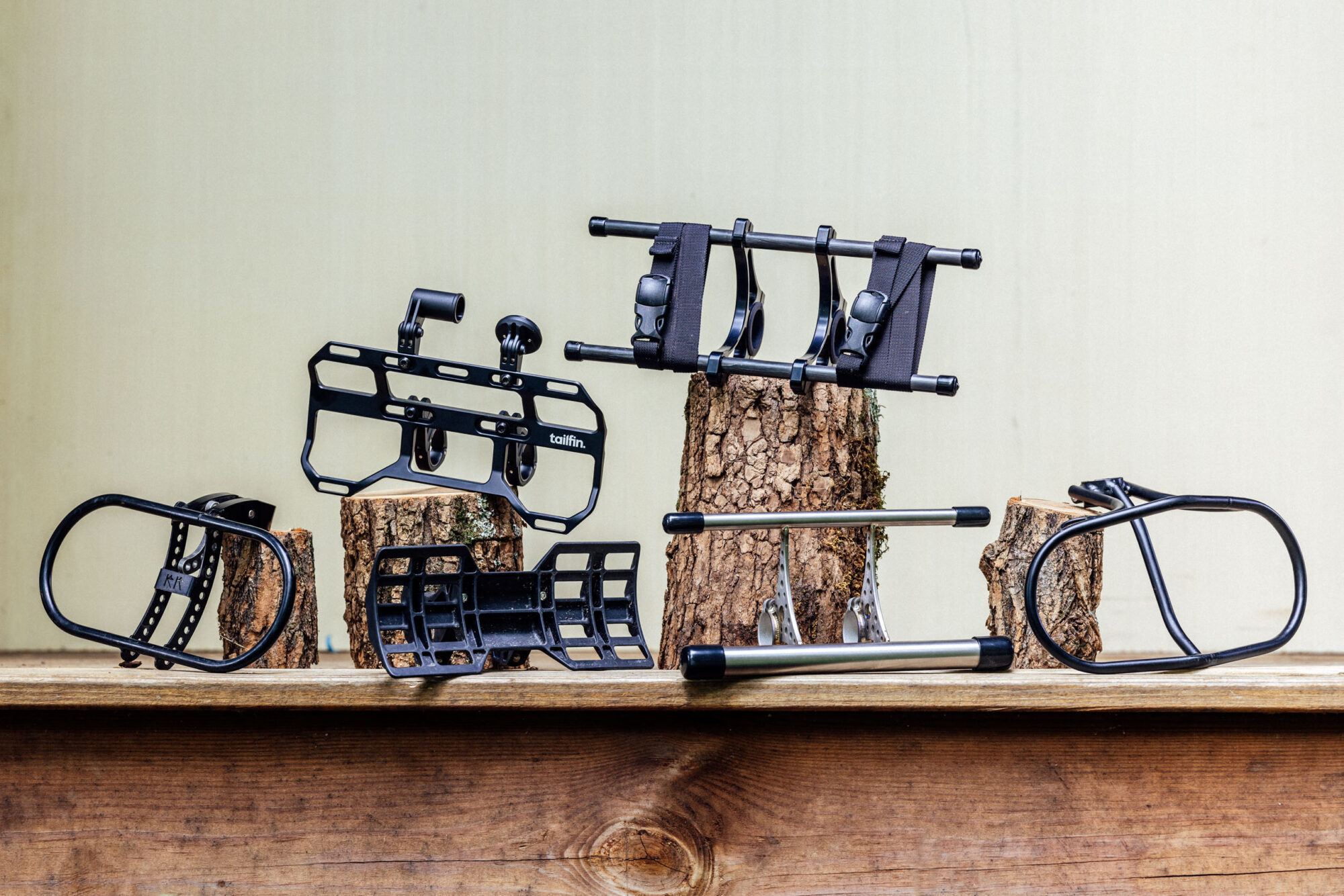
All that being said, it’s hard to pin all these options into one group. Some brands call them mini racks or cages, and others call them harnesses. We think “cradle” is a good term to distinguish them from other types of gear, for the sake of clarity and organization. Still, dissecting this category even further and looking at how they attach, handlebar cradles can be generally split into two camps:
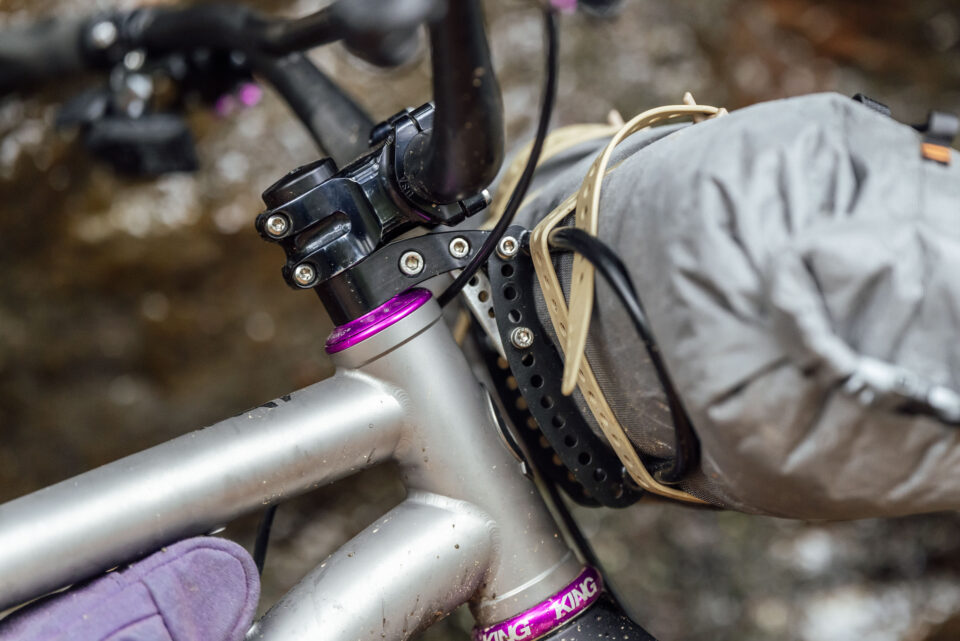
Steerer-mount Cradles
Steerer-mount cradles, such as the Good Day Curiosity Spacer Cradle and Rat King Cradle, are welded cages that use a compression bolt fitting to slide onto and clamp to the fork steerer tube, much like a stem. There are a lot of benefits to this design, including its inherent stability and the fact that it places the weight low. However, it also poses a few challenges. One, they require extra stack height, so if you’re someone who likes a slammed stem, this could be problematic, and some people might not have enough extra steerer tube. Second, you have to remove the stem to slide it on and off, which makes installation and removal more tedious.
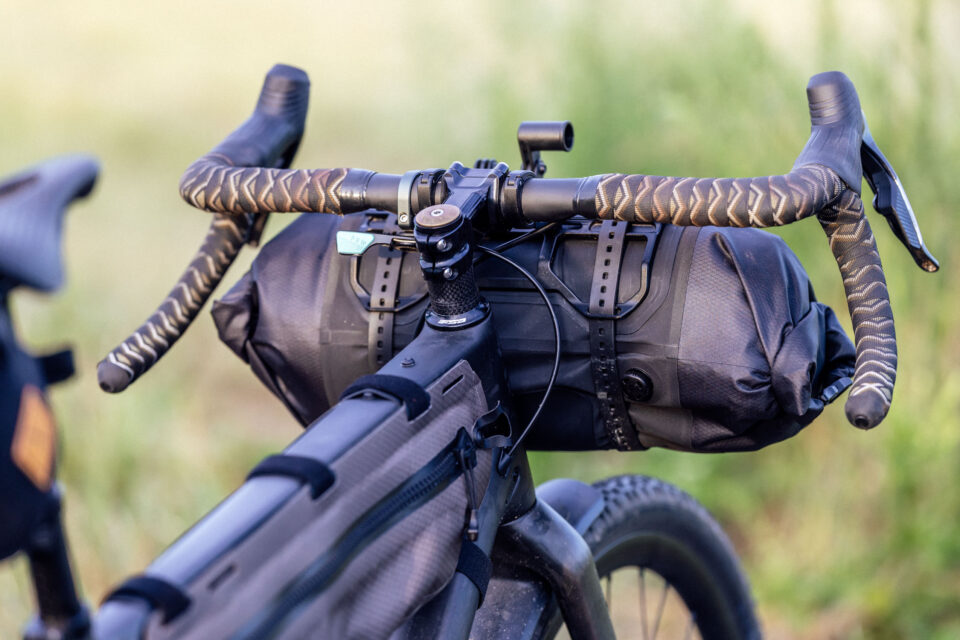
Handlebar-mount Cradles
Handlebar-mounted cradles typically use machined hardware to clamp onto the bars and then clamp or bolt to a cradle, cage, or bars. Most bar-mounted options pivot on a single axis, letting you tilt the load up or down. That’s often a compromise on bikes with short head tubes or tight tire clearance, where you’re forced to run the rack higher and farther out than ideal. This can negatively affect handling, which generally improves when weight sits lower and closer to the head tube. Still, handlebar cradles are easier to remove and attach than steerer-mount options, and they don’t require extra stack under the stem, which could jeopardize fit.
The Complete List of Handlebar Cradles
For this Gear Index, we’ve compiled all the handlebar cradles we could find that fit this genre, many of which have been rigorously tested. We’ve also included key information to help you pick the right one, including the type, load rating, and where it’s made. You can also dig in to find the weight and other details. As usual, the ones we’ve tested are marked with a hexagonal “T” icon and are listed first.
-
£45
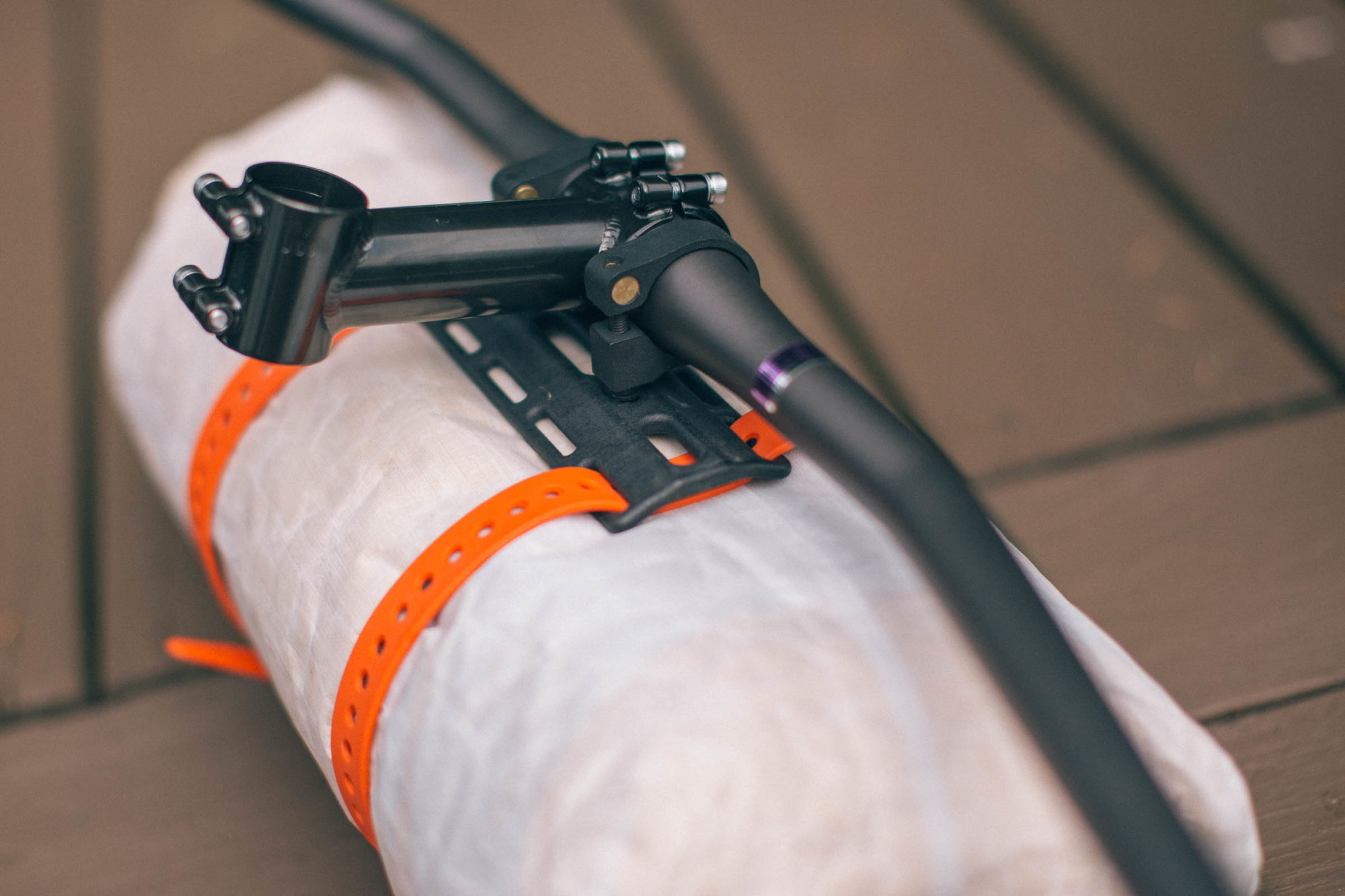
Drj0n G-Funk Handlebar Strap Deck System
- Type: Handlebar Cradle
- Load Rating: 1.6kg (3.7lbs)
- Made of: 3D Printed Nylon
- Made in: UK
CloseThe G-Funk Handlebar Strap Deck System consists of two Drj0n products—the DeWidget G-Funk Clamp and DeWidget Strap Deck. The G-Funk clamp is a minimal handlebar clamp that provides a secure place to mount the Strap Deck, which then can be used to lash a small drybag or tent in place for bikepacking. Both components are made from 3D printed nylon, and extremely lightweight. The G-Funk Clamps are flexible enough to easily open up to fit on any standard 31.8mm (or 35mm) handlebar without removing grips or controls, and use a cross dowel nut and button head bolt to keep everything in place.
The Strap Deck simply mounts to the clamps, using the included bolts, to create a cargo cage-like platform for mounting a small drybag, lightweight tent, or sleeping pad. The design allows the clamps to be mounted in several different orientations, positioning the Strap Deck in front or directly below your stem. Drj0n’s products are available to purchase from Wildcat.cc, Backcountry.Scot, Straight Cut Design, Wizard Works, and more.
Pros
- Low profile and lightweight
- 3D printed in the UK
- Always improving on the design and product offerings
- Strap Deck can be used on standard bottle mounts as a cargo cage
- Affordable
Cons
- Not compatible with all bars and stems
- Limited to 3.7lbs of gear. Might not be enough for everyone
- A few small parts to keep track of. Don’t lose them!
- Weight: 61 grams (2.2 oz)
- Price: £45
- Place of Manufacture: UK
- We highly encourage you to buy from a local shop when possible, but if you're going to buy online, you can use our affiliate links. We'll get a very small kickback that will help support this site. Available at:
- Manufacturer's Details: Link
-
$180
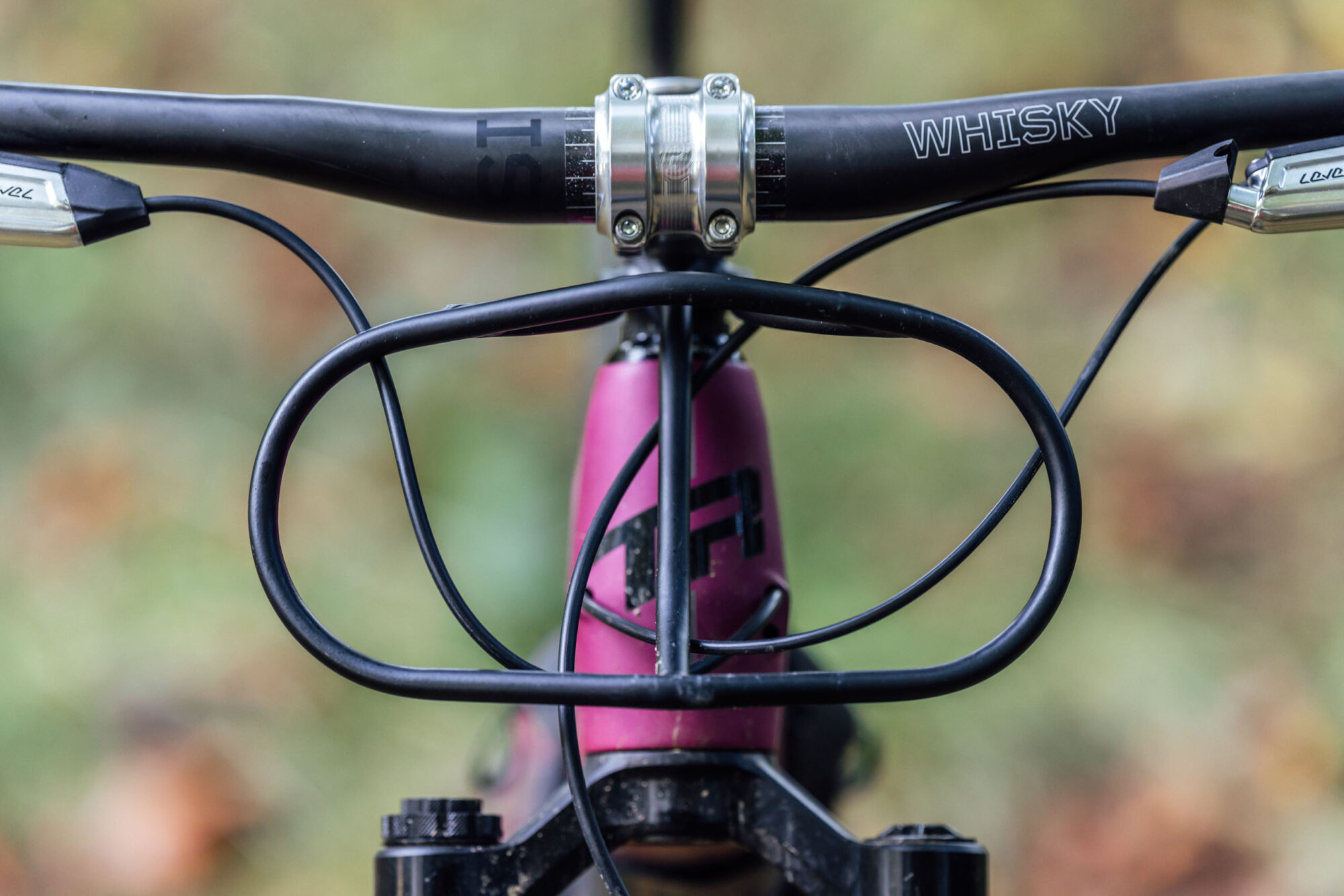
Good Day Curiosity Spacer Cradle
- Type: Steerer-mount Cradle
- Load Rating: 4.54 kg (10 lbs)
- Made of: 4130 Chromoly Steel Tubing
- Made in: Colorado, USA
CloseGoodday + Curiosity’s Spacer Cradle is a minimalist, non-adjustable steel mini-rack that mounts on the steerer tube rather than the handlebar, replacing a 20 mm spacer (custom sizes 15–50 mm available). Released in late 2022 after several prototypes, it’s built from bent 3/8″ 4130 Chromoly tubing welded to a cylindrical, single-bolt spacer clamp and finished with matte black powder coat. The oval cradle (230 mm wide) includes strap-guide loops and evolved from earlier parallel-bar designs to avoid bag wear and eliminate vibration with a stiffer three-piece truss and 0.028 wall thickness.
By sliding onto the steerer, the Spacer Cradle pushes the load slightly forward and down, creating a cavity for brake/shift/dropper lines to pass cleanly behind the bag. It’s worth mentioning that the rounded profile and tubing are cable friendly and don’t cause any unwanted abrasion on cable housing.
The Spacer Cradle is intended for fast, light “shred-packing,” not heavy touring, and is rated to 10 lb (4.54 kg)—reflecting designer Chris’s philosophy of keeping weight low and centralized (ideally in the frame triangle) and choosing routes with frequent water/resupply to minimize the load.
On-trail testing matched those goals. A medium roll around seven inches (17.8 cm) in diameter carrying tent body (no poles), sleeping bag/pad, and pillow—about 4 lb 2 oz (1.87 kg)—nested neatly into the concave cradle and stayed put on chunky rides. The included Velcro straps proved secure and convenient (they can stay threaded when the bag is off), though Voilé straps would also work well. Steering felt normal with the load’s position just in front of the bars and played nicely with a suspension fork; lower would be even better, but could reduce compatibility on short head tubes.
Despite its all-steel build, the cradle is remarkably light at ~230 grams, undercutting many bar rolls/harnesses in the 300–450 gram range. It keeps weight close to the bar for familiar handling while solving cable rub—especially useful on frames with tricky, forward-facing cable ports.
Overall, the Spacer Cradle is a refined, purpose-built solution for riders who want a light, completely rigid, cable-friendly front carrier without a full rack. It excels with narrow, compact loads; although it may be less ideal for very large-diameter bags, long bags, or on bikes with extremely short head tubes. And with no moving parts and a strong steerer connection, it’s hard to imagine something more reliable.
Pros
- Solid bag cradle that’s great for trail-oriented bikepacking and particularly well-suited for use on bikes with suspension forks
- Design does a good job at minimizing cable/bag interference
- Handmade in Gunnison, Colorado
- Universal system that works on a variety of bikes
- Simple three-truss design seems bombproof
Cons
- Limited to smaller loads; but that’s what it’s made for
- Relatively expensive
- Could be engineered to position the load a couple of centimeters deeper
- Won’t work if the stem is slammed to the head tube with no steerer tube space
- Weight: 230 grams (8.1 oz)
- Price: $180
- Place of Manufacture: Colorado, USA
- Manufacturer's Details: Link
-
€128
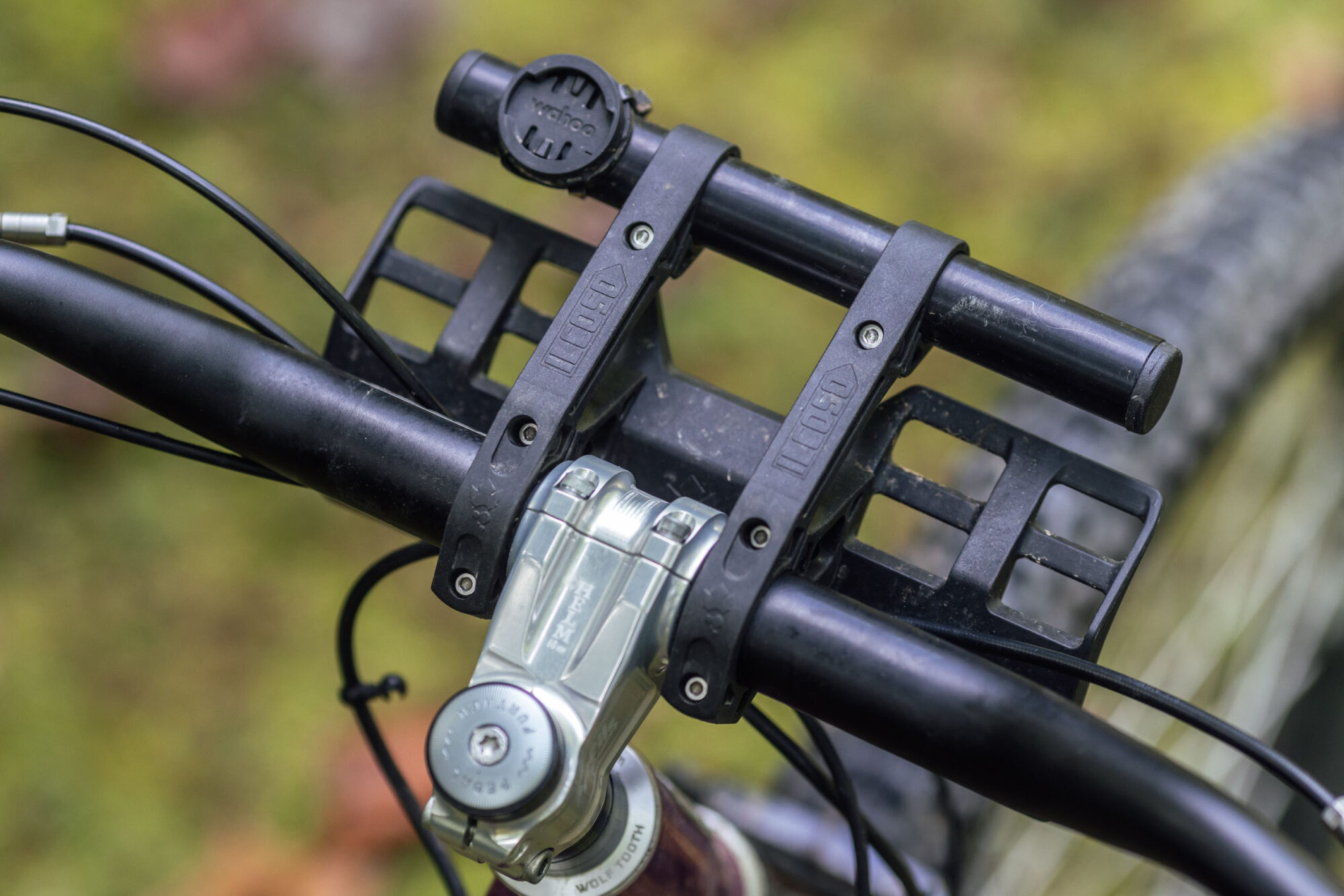
Miss Grape Ilcoso
- Type: Handlebar Cradle
- Load Rating: 3 kg (6.6 lbs)
- Made of: PA6 polyamide
- Made in: Italy
CloseThe Miss Grape ILCOSO (“eel-koso”) is a modular, handlebar-mounted cradle that combines a lower dry-bag rack with an upper accessory bar for lights or a GPS. Built from PA6 nylon with an anodized-aluminum accessory tube, it mounts to 31.8 mm bars (min. 83 mm clamp width) using two bracket lengths and tilt adjustment, and it includes two captive webbing straps. Miss Grape recommends dry bags up to 19 cm (7.5″) diameter, with a rated load of 3 kg (6.6 lb).
Assembly involves eight main pieces (cradle, clamps, accessory bar, and optional top brackets) and offers four cradle orientations, letting you prioritize a low, tucked load or raise the accessory bar so light beams clear the bag. Hardware and protective 3M strips are included (for the bars to prevent rotation). Once installed, the setup is pretty clean with cables routed behind the load and extra real estate for devices.
Initial setup can feel fiddly due to multiple small fasteners, and the 3 mm Allen bolts are easier to strip than larger or Torx hardware. In early rides, Neil experienced a little downward rotation on carbon bars, but I had zero movement on mine throughout a 200-mile bikepacking trip with a bag that contained a three-person tent, quilt, inflatable sleeping pad, and a pillow. For Neil, Miss Grape advised tightening the bolt until slipping stops, noting the plastic clamps conform to varying bar finishes without the risk of cracking carbon. That solved it for Neil.
Out on the trail, we both found that ILCOSO worked well with medium-sized bags—perfect for sleeping kits and extra layers. Compared with Salsa’s EXP Anything and Aeroe’s Spider cradles, it’s more adjustable and lower profile, while also lighter than those two (~320 g) but also with a lower load rating. Its smaller cradle, which can introduce some movement with larger loads on fast descents; swapping to Voilé straps tightened things up, however
Find our full review here.
Pros
- Modular system provides several positions to orient the cradle and an accessory bar
- Lightweight
- Accessory tube is excellent for providing extra mounting options for GPS devices and lights
- Eliminates contact with frame but doesn’t protrude too far from the bars
- Cradle holds its position well when tightened properly
- Leaves more room for hands and cables
Cons
- Not compatible with 35mm bars
- Many small parts and hardware to keep track of
- 3mm bolts are easy to strip and no torque spec
- More expensive than comparable cradles
- Small cradle isn’t ideal for large dry bags or heavy loads
- Weight: 320 grams (11.3 oz)
- Price: €128
- Place of Manufacture: Italy
- Manufacturer's Details: Link
-
$215
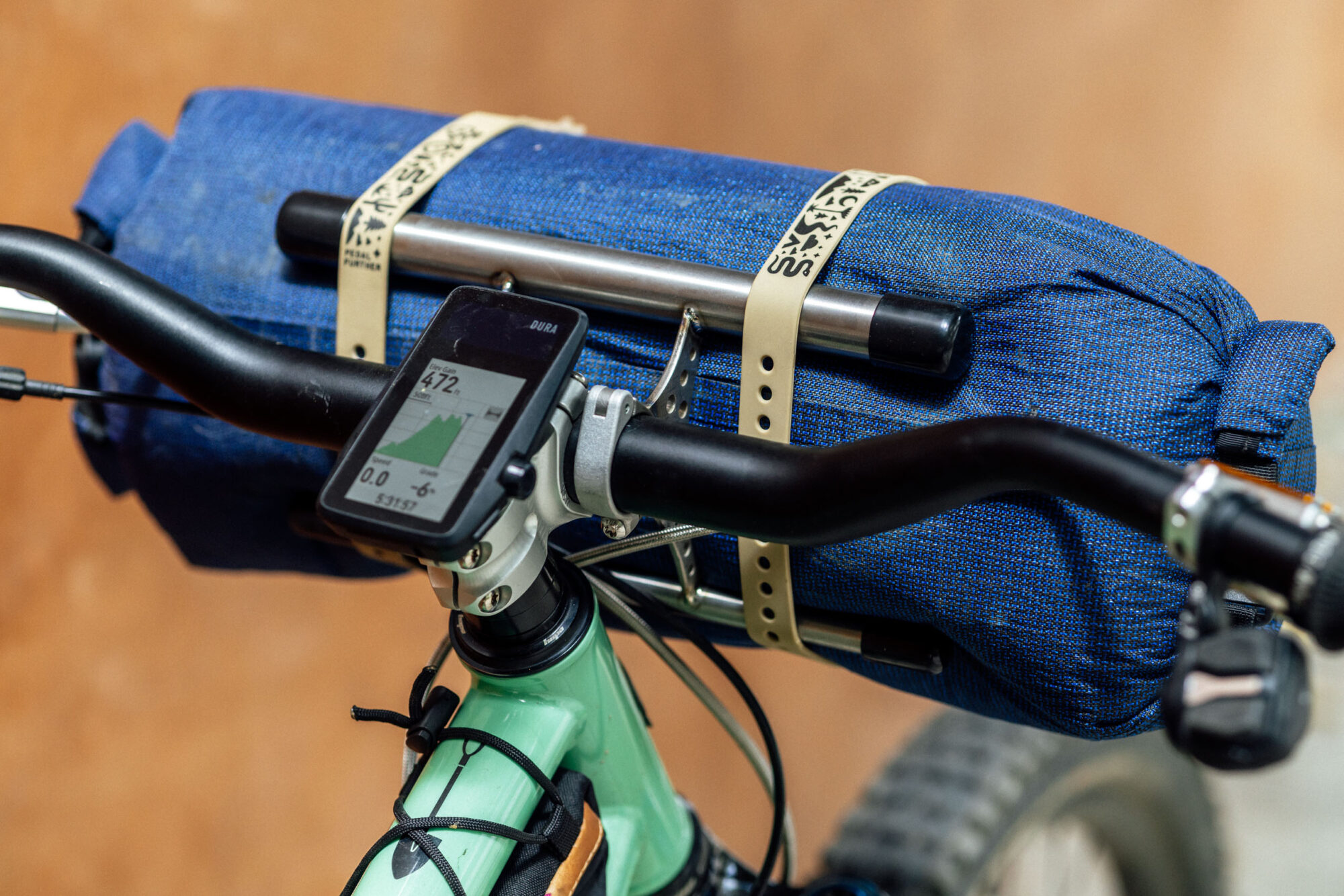
Mostly Forever Titanium Bedroll Harness
- Type: Handlebar Cradle
- Load Rating: Not Specified
- Made of: Titanium
- Made in: Oregon, USA
CloseWe first met Max Keegan, founder of Mostly Forever (MF) Bikes, at the 2023 MADE Bike Show, and later spotted a prototype titanium handlebar cradle on his 2024 Arizona Trail Race rig. A year on, that prototype has launched as the MF Bikes Titanium Bedroll Harness, which I’ve been testing for this Gear Index mini review.
Functionally the Bedroll Harness—effectively a rigid cradle—is made from two 10″ titanium tubes: a 7/8″ upper that’s sized to mount accessories and a 1/2″ lower. Both of these are welded to a pair of “drillium” trusses mounted to swing clamps on either side of the stem. The trusses are designed to move the load down, but it’s not as low as some other designs, which makes it more fitting for bikes with front suspension or little clearance between the front tire and bag.
It’s offered with two different clamp sizes for 31.8 mm or 22.2 mm bars. The clamp backs are aluminum while the rest is titanium, trimming weight without sacrificing stiffness. Speaking of weight, this is the lightest one in this roundup, tipping the scale at a scant 210 grams (7.4 oz)—about 100 grams lighter than the Miss Grape ILCOSO.
In use, I’ve been very impressed with the Bedroll Harness. I’ve been running it on a 160mm travel hardtail, which is a perfect use case. The orientation keeps the load relatively high, so there’s plenty of front tire clearance for a bike like this. It would also be a good option for smaller bikes where clearance is a challenge.
I torqued the clamps to about 6nm and haven’t experienced any rotation. There aren’t any strap keepers of any sort, but as Max suggested, you could zip-tie Voilé straps to the tubes for a tidy, fixed setup. The included rubber end-caps also help keep the bag from sliding left or right. It’s as solid as they come. I might worry about the hinges having an issue on a big trip, but I haven’t had any issues so far and will report back if I do. Perhaps my only real con is that it’s hard to get. During the first pre-order, Max only made 16.
Pros
- Super stable with with wide bars
- Very well made
- Made by small maker in USA
- Lightest cradle available
Cons
- Load placement might be a little high for some people
- The pin-hinges could be hard to repair, but have been solid so far
- Hard to get
- Weight: 210 grams (7.4 oz)
- Price: $215
- Place of Manufacture: Oregon, USA
- Manufacturer's Details: Link
-
$166.60
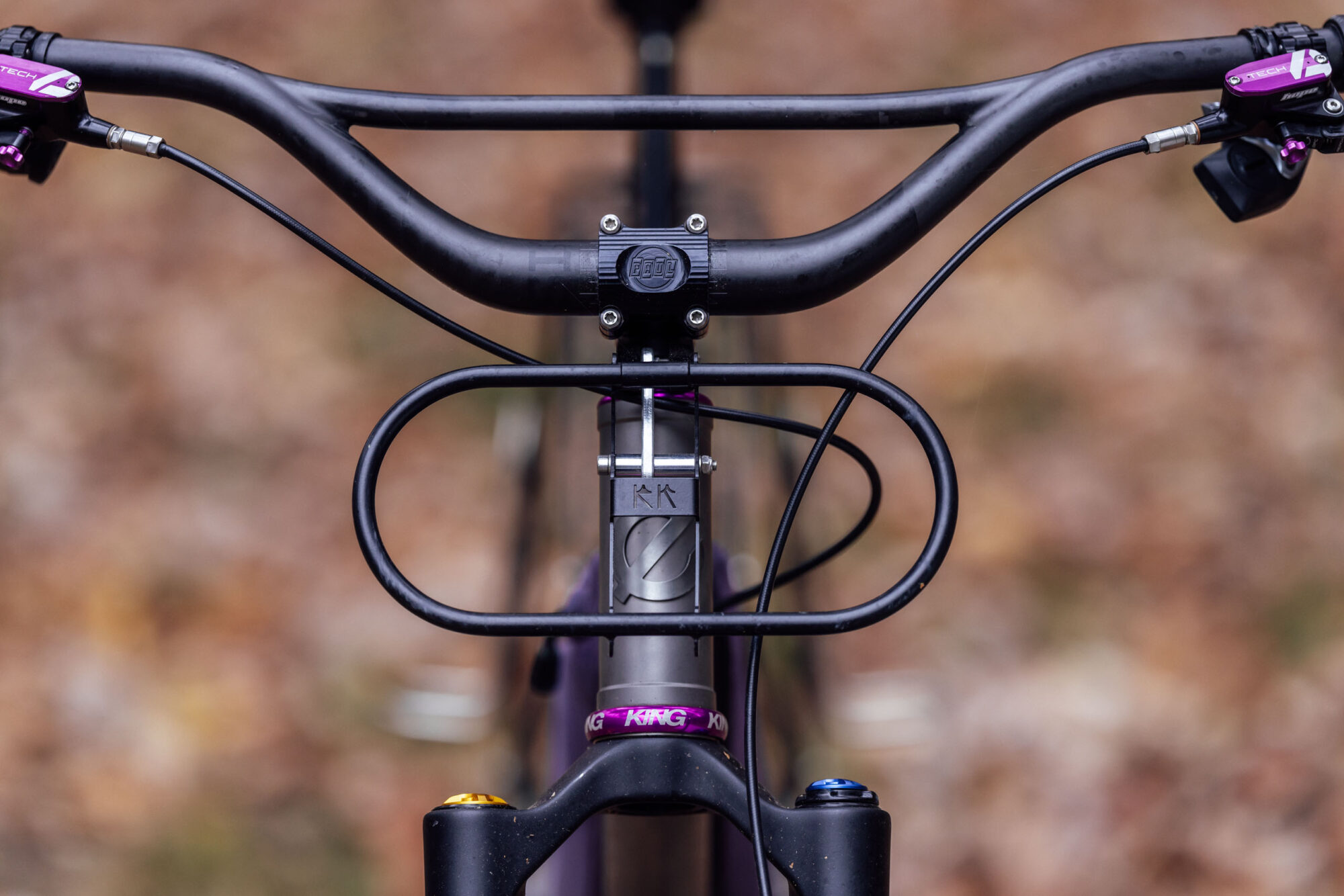
Rat King Cradle
- Type: Steerer-mount Cradle
- Load Rating: Not specified
- Made of: Chromoly steel and aluminum
- Made in: Oregon, USA
CloseThe RatKing Cradle is a versatile mini-rack that can mount either to the fork steerer as a front dry-bag platform or to a 27.2 mm seatpost (with a shim) to support a rear bag. Its machined-aluminum mount has a 1 1/8″ bore and places the platform about 80 mm forward of the steerer center, replacing 20 mm of spacers when installed up front. Installation uses a 5 mm hex; angle adjustments are made with a 4 mm hex and an 8 mm open-end wrench (e.g., Forager Link Wrench). Note that is’t not for use on carbon steerers or seatposts. The platform measures 115 × 245 mm (4.5″ × 9.75″).
An adjustable tilt lets you fine-tune clearance and load position around short stems, minimal spacer stacks, short head tubes, or suspension forks—making fitment likely on a wide range of bikes. I tried it on a couple of bikes, and the adjustable curved bracket allows you to neatly tuck in the load close and low, which is a major plus.
The beauty of this style of cradle is that the steerer tube anchors it in place, and there’s no chance of it rotating downward, unlike handlebar-mounted cradles. As such, it’s rock solid and worry free, even on the roughest of descents. Using a couple Voile straps, I never had a problem with the front bag sliding or rotating. I guess my only real complaint with it in use is that I wish it had some way of securing the straps, like the Hunter Cycles Nubz or something similar.
Rat King doesn’t specify a load rating for the Cradle, but I expect it has a similar 3-kilogram maximum as other racks here. The Rat King Cradle with hardware weighs 256 grams, comes in black or chrome, and is priced at 166.60.
Pros
- Strong, immovable cradle system
- Oval rack keeps the load in place and very secre
- Still lightweight
- Made in the USA
- Excellent design that rotates to adjust position
Cons
- Lots of parts
- Cumbersome to remove and install (requires removing stem and bars)
- It would be nice if there were strap keepers of some sort
- Could be a little wider
- Weight: 256 grams (9 oz)
- Price: $166.60
- Place of Manufacture: Oregon, USA
- Manufacturer's Details: Link
-
$185
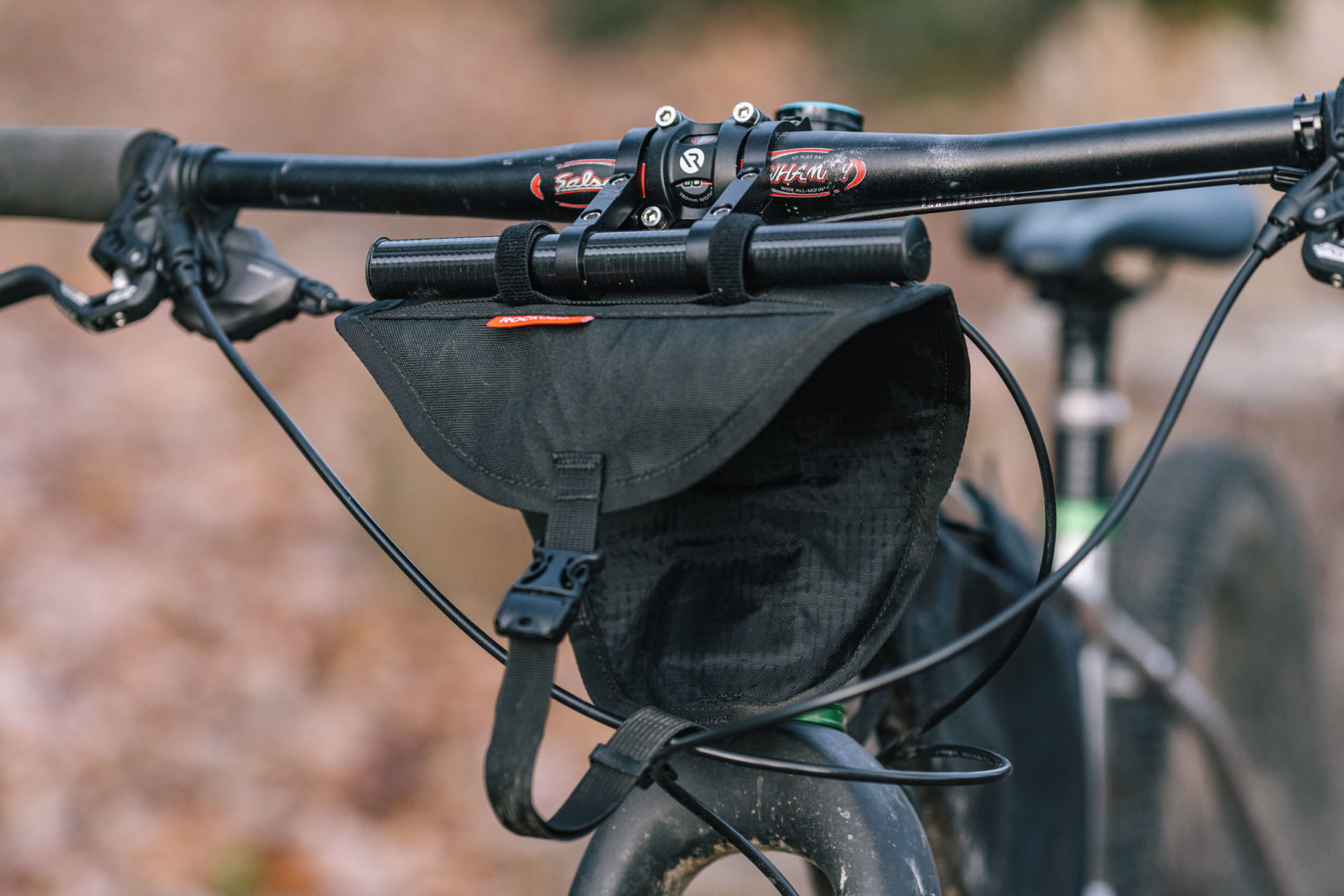
Rockgeist BarJam
- Type: Handlebar Cradle
- Load Rating: Not specified
- Made of: Aluminum, carbon, fabric
- Made in: North Carolina, USA
CloseRockgeist’s BarJam isn’t a full-hardware cradle like some of these other designs, but it arguably inspired many of them. It began as a shop fix for saggy handlebar rolls: Greg and one of his teammates added a short extension bar and two Voilé straps to carry the load off the bars. The fabric harness plus carbon crossbar, held by aftermarket alloy clamps, immediately stabilized the bag and pushed it forward to create a clean channel behind the load so brake, shift, and dropper cables could pass without rubbing.
What started as a proof-of-concept evolved into a fully reworked production system with locally machined 6061-aluminum brackets (Asheville, NC) and a U.S.-made carbon bar (Washington state). The move to domestic hardware increased strength, finish quality, and kept revenue local—at the cost of a higher price but a clear jump in durability and refinement.
The BarJam system is comprised of five parts: two alloy handlebar brackets, the carbon bar, two Voilé straps, a dry bag, and the harness. The brackets clamp to the bar’s stem area (31.8 or 35 mm), then cinch the carbon crossbar with a separate M5 bolt, forming a Pi-shaped soft-rack. Because the crossbar bears the load, you avoid weight-bearing straps on the handlebar itself, gain bar space, and keep the payload lower and outboard to minimize cable interference.
Rockgeist kept the X-Pac harness simple: reinforcements where needed, daisy chains, a single compression strap to locate the dry bag, and two 25″ Voilé straps that do the heavy cinching to the carbon bar. Light Velcro loops hold the harness in place during setup. Underneath, a vertical daisy chain offers three positions for a head-tube strap; future revisions will add a slotted foam puck for spacing and protection.
In use, the concept is straightforward: mount the brackets and bar, set the harness, then let the Voilé straps create a tight, rattle-free connection. I preferred a Voilé Nano strap and foam block at the head tube for extra security and paint protection, a small tweak that aligns with the BarJam’s core idea—simple hardware that stabilizes the load.
Pros
- Super stable drybag harness system; perhaps the most stable “soft harness” on the market
- New brackets and bar seem very well made and durable
- The handlebar brackets free up room for cable housing, which is a benefit to cradle systems
- Dyneema bag and Horton are highly waterproof
- Extremely lightweigh
Cons
- Still requires attachment to head tube
- Weight: 284 grams (10 oz)
- Price: $185 (Hardware, harness, and straps )
- Place of Manufacture: North Carolina, USA
- Manufacturer's Details: Link
-
$240
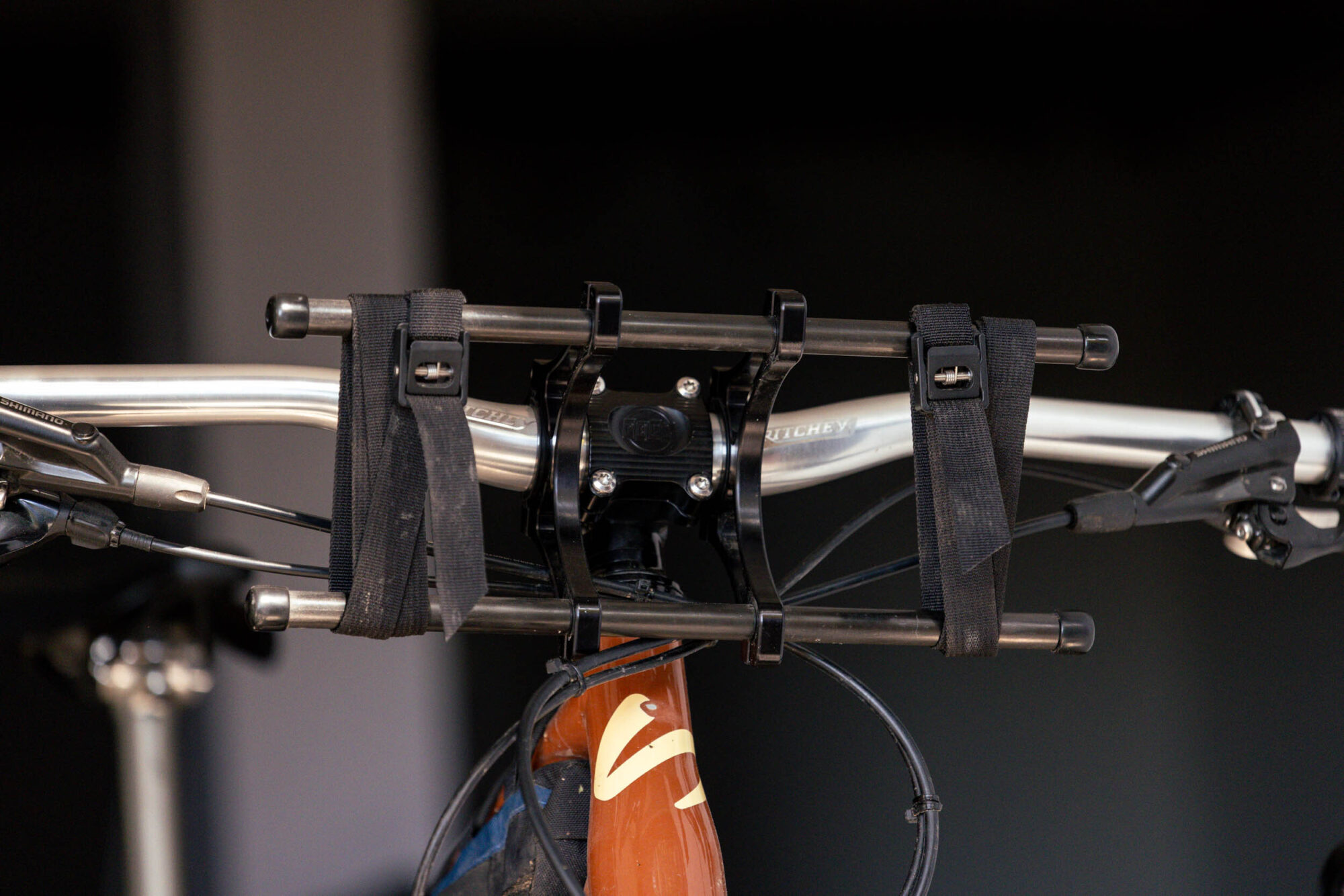
Rogue Panda Blue Ridge Handlebar Harness
- Type: Handlebar Cradle
- Load Rating: 3 kg (6 lbs)
- Made of: Aluminum and carbon
- Made in: Arizona, USA
CloseThe Rogue Panda Blue Ridge Handlebar Harness is an ultralight, bar-attached cradle that uses two CNC-machined aluminum clamps to hold a pair of 12″ (30.5 cm), 13 mm carbon rods. Two straps (nylon or optional Austere ¾” cam buckles) thread over the rods to cinch a dry bag or cylindrical load, with rubber rod tips preventing strap walk-off. 3D-printed two-piece shims (22.2, 31.8, 35 mm) adapt the clamps to most bars.
Setup is straightforward and notably adjustable: you can loosen the clamp rings to fine-tune angle and width around wider stems. Recommended torque is 3 Nm for the pinch bolts and 6 Nm (or your bar’s limit) at the clamps. Neil found the best way to fit it is to loosely fit the harness, place the bag to clear the head tube/cables by ~½”, then torque to spec for a clean, tucked, frame-free mount. And like other cradles, it doesn’t require a head tube strap.
On the trail, the Blue Ridge proved impressively stable. Across rough Arizona singletrack and multi-day shakedowns, the clamps didn’t slip, and the long carbon rods limited bag sway or movement even with wider loads. My only complaint with the Blue Ridge is that sometimes the bag slides right or left when using a relatively slippery Dyneema composite bag (Ultra). Rogue Panda rates the off-road load at ≤ 3 kg (6 lb).
Weighing ~240–252 g (depending on shims/straps), the Blue Ridge undercuts many hardware cradles, and compared with options like the Salsa Anything Cradle or Miss Grape ILCOSO, it’s simpler, lighter, and offers broader bar compatibility. Pricing reflects small-batch U.S. production: $185 for the harness, shim sets $10 (31.8/35 mm) or $20 (22.2 mm), and +$40 for Austere cam straps. If you prioritize a minimal, stable, and highly adjustable bar cradle—and can live without a hinged clamp—the Blue Ridge is a standout. Dig into the full review here.
Pros
- Very stable harness system
- Extremely lightweight compared to other cradles
- Made in the USA
- Adjustable stem spacing
- Simple, well-thought-out design that works great with drop and flat bars in three bar diameters!
Cons
- Expensive due to sourcing local parts
- Would love a hinge bar clamp option
- Installing the clamps to the bar can be a little cumbersome
- Slippery bags can slide left or right on carbon bars
- Weight: 240 grams (8.5 oz)
- Price: $240
- Place of Manufacture: Arizona, USA
- Manufacturer's Details: Link
-
$200

Tailfin Bar Cage
- Type: Handlebar Cradle
- Load Rating: 3 kg off-road
- Made of: 7075-T6 Aluminum, 6061 Aluminum
- Made in: Taiwan
CloseThe Tailfin Bar Cage distinguishes itself with a dual-axis adjustment system: one pivot at the handlebar clamps and a second at the cage. This double rotation lets you fine-tune height and angle independently—tucking the load close to the head tube on tight setups or raising/tilting as needed for tire clearance—something most rival cradles (Rogue Panda Blue Ridge, Salsa Anything Cradle, Miss Grape Ilcoso) can’t match. The hinged, machined-alloy clamps work with 31.8/35mm bars (via shims) and place the cage about 50mm forward of the bar center.
Mechanically, the cage locks to the brackets with a knurled keyed interface and a barrel bolt; in testing it held angle securely over rough singletrack and offers ~135° of rotation. Tailfin built an ecosystem around it: three waterproof Bar Cage Packs (8L/11L/15L) with welded construction, Hypalon reinforcement, air-bleed valves, MOLLE panels, and internal carbon struts for stiffness. The clever Speed Hooks act like a “third hand,” catching the bag on the cage so you can strap it down easily.
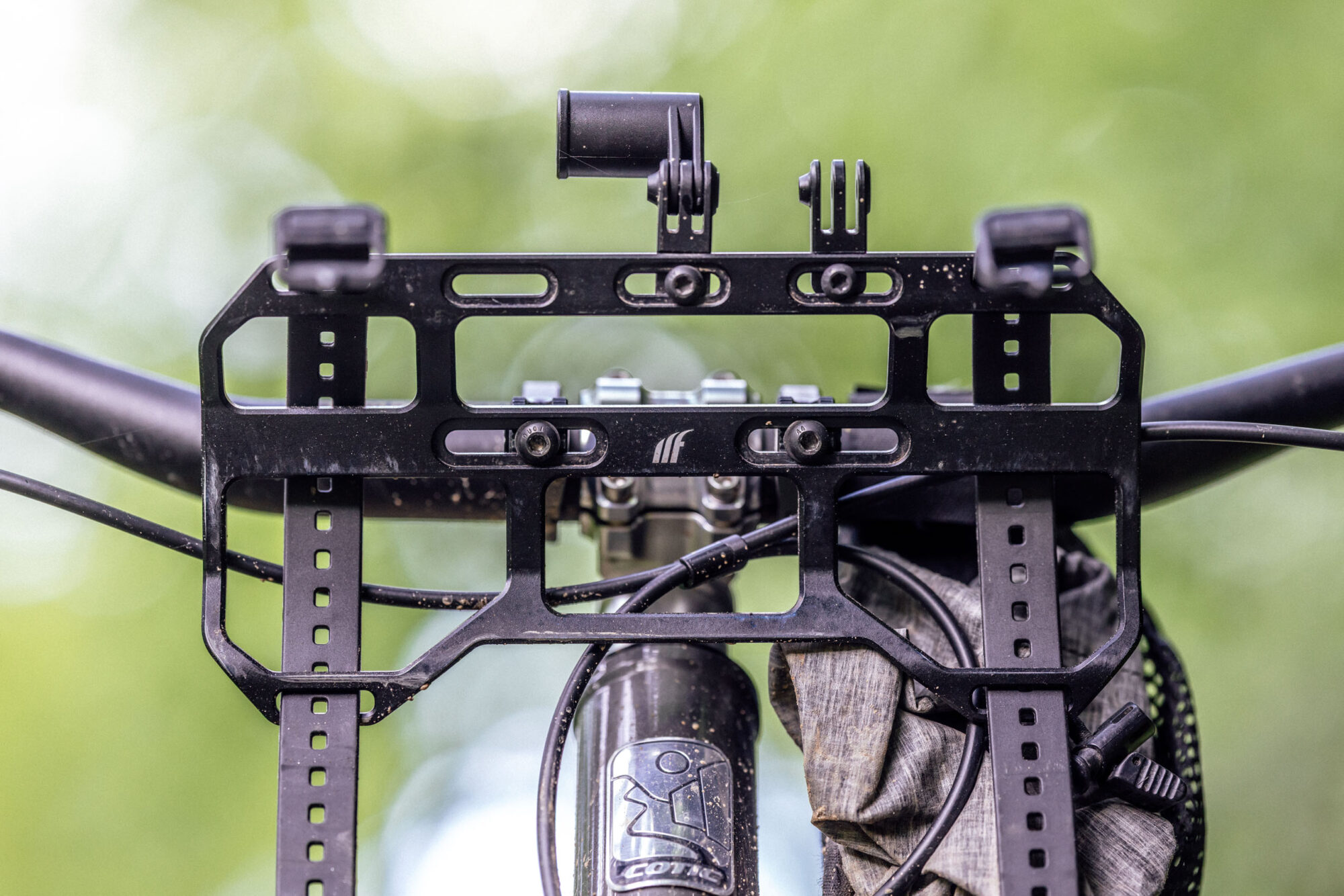
On-trail performance was solid on both a gravel bike and two MTBs. With typical sleep-kit loads (within Tailfin’s 3 kg off-road limit), the clamps and cage never rotated, even on chunky descents; recommended torque (5 Nm carbon, ~6 Nm alloy) was sufficient. The 11L and 15L bags feel well-proportioned for most setups, while the 8L suits tight clearances or ultralight kits.
Quibbles are minor: mixed fastener standards (T25 at the clamps, 4 mm hex at the cage) and the 11L bag feeling a touch shorter than some wide “burrito” rolls. Overall, the Bar Cage is one of the most refined, adaptable handlebar cradles available—easy to position, stable under load, and supported by a thoughtful bag system—making it an excellent choice if you’ve been waiting for a truly dialed mini-rack alternative. Read the full review here.
Pros
- Highly adjustable cage and load placement
- “Third-hand” hooks on bag are a nice touch, making it easy to hold in place while strapping or removing from cage
- Dual pivot points and multiple bag sizes make it very versatile, adapting to a wide variety of stem and handlebar setups
- The cage and hardware are relatively lightweight
- Accessory attachments for light and GPS units add even more utility
- Nice details on the bags, such as air release valve, slotted attachments at front, and reinforced area where it sits in cage
- Stable and secure design
- Easy to install, relatively lightweight, and competitively priced
Cons
- Two bolt-head standards used for each axis connection are annoying: T25 Torx on handlebar bracket, 4mm Allen on cage attachment
- Only comes in black
- I wish the middle and smaller-sized bags were longer
- No shims for 22.2mm bars
- Weight: 234 grams (8.3 oz)
- Price: $200 (8L)
- Place of Manufacture: Taiwan
- Manufacturer's Details: Link
-
$109
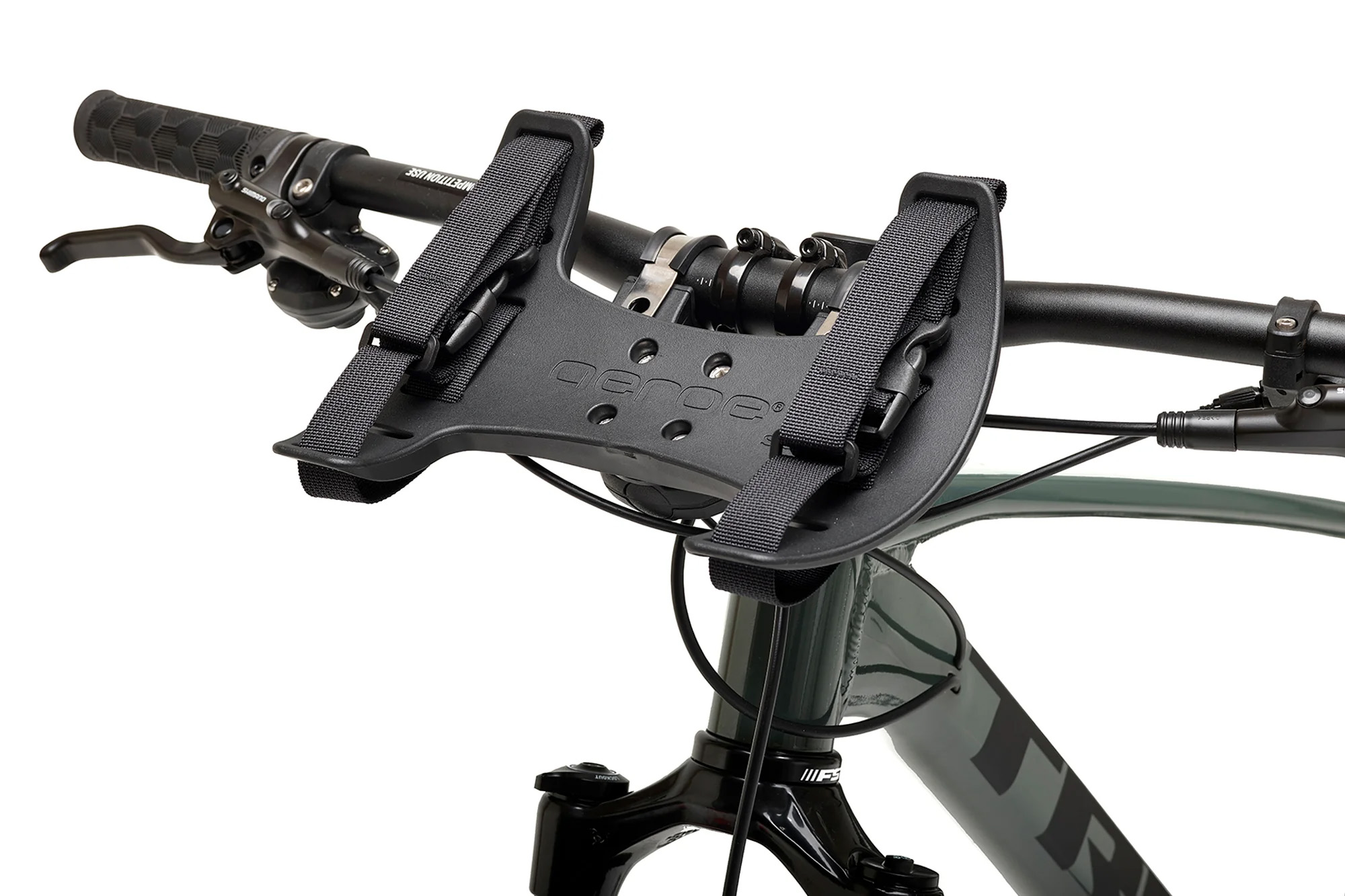
Aeroe Spider Handlebar Cradle
- Type: Handlebar Cradle
- Load Rating: 5 kg (11 lbs)
- Made of: Stainless steel, aluminum, nylon, silicone
- Made in: Taiwan
CloseWe haven’t tested this one, but according to Aeroe, the Spider Rack easily snaps onto your handlebar with a patented quick-release mount, creating a stable cradle that stays clear of the head tube and cables. It carries a wide range of gear—use Aeroe dry bags or your own—and the built-in, silicone-coated straps make loading fast and fuss-free (no extra straps to juggle). Engineered from stainless steel, anodized aluminum, and glass-reinforced nylon, it weighs 464 g (1 lb) and is rated to carry 5 kg (11 lb) off-road.
- Weight: 464 grams (16.4 oz)
- Price: $109
- Place of Manufacture: Taiwan
- Manufacturer's Details: Link
-
$248
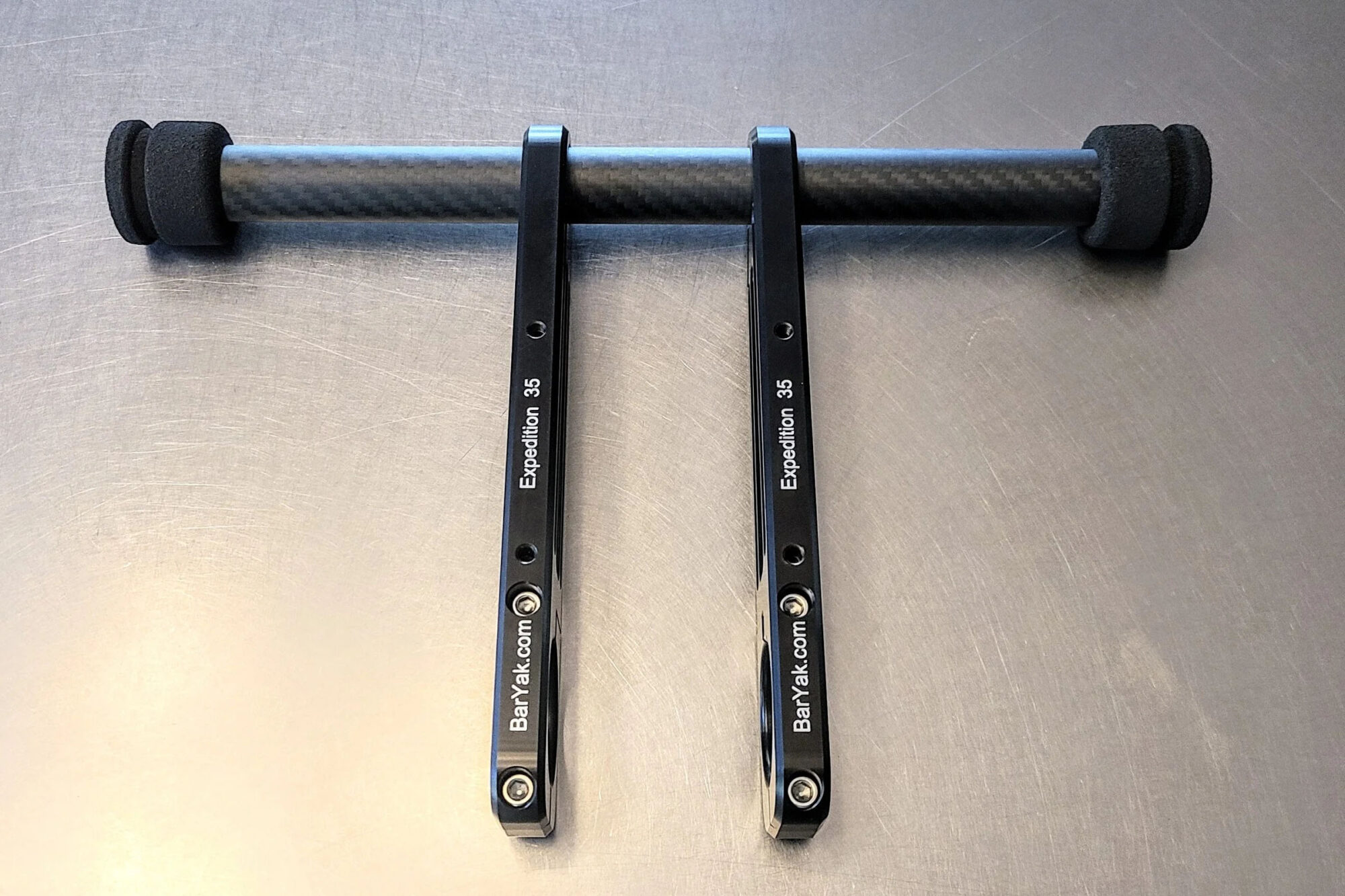
BarYak
- Type: Handlebar Cradle
- Load Rating: 68 kg (150 lbs)
- Made of: Aluminum and Carbon
- Made in: USA
CloseLong before most of the cradles in this list existed, BarYak set out to solve the problem of bikepacking bags and systems that interfered with braking and shifting performance. The BarYak system supports handlebar-mounted bags, lightweight armrest systems, harnesses and bags, and even fork-mounted cargo. There are several different variations available, but they all rely on US-made aerospace-grade 6061 aluminum handlebar brackets, lightweight carbon crossbars, and the option to add armrests, GPS mounts, a minimal fabric bag harness, and more.
- Weight: 447 grams (15.8 oz)
- Price: $248 (BarYak Expedition)
- Place of Manufacture: USA
- Manufacturer's Details: Link
-
$275
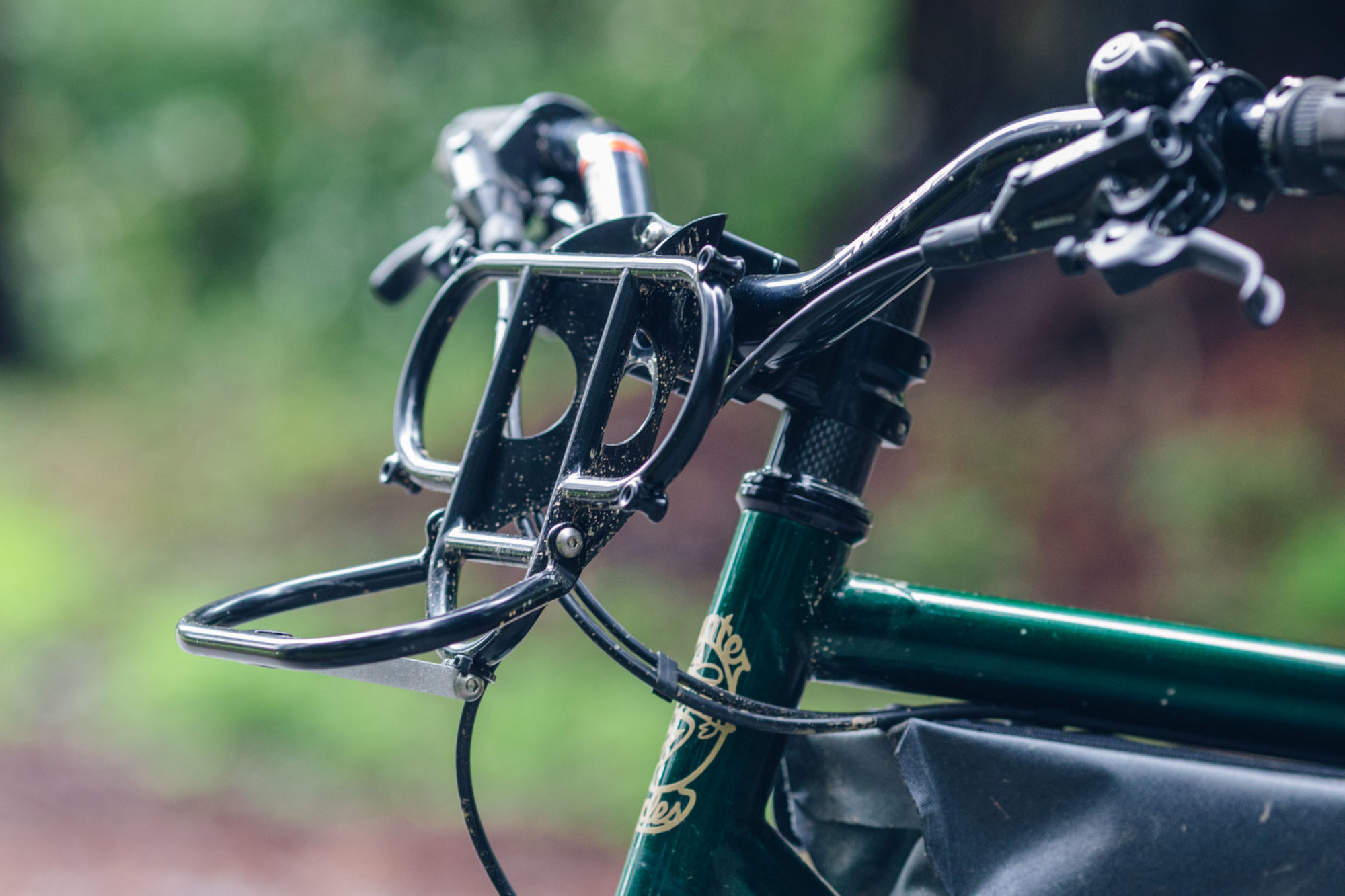
Hunter Cycles Cow Catcher
- Type: Steerer-mount Cradle
- Load Rating: Not Specified
- Made of: Chromoly steel tubing
- Made in: California, USA
CloseThe Hunter Cow Catcher Stem Rack—designed in collaboration with PAUL Components—mounts via a custom PAUL Boxcar faceplate, creating a bent-L platform to strap a dry bag, tent, or tools while keeping the load independent of the bars. Built from 4130 chromoly with an aluminum faceplate, it also adds two pairs of braze-ons for cages or custom attachments.
The Cow Catcher comes in sizes: Day Rider (180 g) and Tour (320 g, hinged lower shelf), priced at $275 including the faceplate. Rated to 20 lb (real-world sweet spot 5–10 lb), it’s aimed at MTBs/trail bikes with short stems and flat/riser bars—great with suspension forks and light backcountry setups, not a full rack replacement. It fits a 10–15 L dry bag with the intention of being secured via two Voilé straps to yield a tight, rub-free solution for anything cylindrical: bear cans, rafts, trail tools all proven. Caveats: you’ll need a Boxcar stem (about $141), and the load rides a bit higher than a bar roll—but the Boxcar is a durable, trusted component, and performance looks promising. Make sure to check out my first look from a shop visit at Hunter.
- Weight: 333 grams (11.7 oz)
- Price: $275
- Place of Manufacture: California, USA
- Manufacturer's Details: Link
-
$95

Mountain Laurel Designs Border Handlebar Harness System
- Typw: Handlebar Cradle
- Load Rating: 5 kg (10 lbs)
- Made of: Aluminum and Carbon
- Made in: USA/China
CloseThe MLD Border Handlebar Harness system is a simple, strong, and lightweight dual-clamp-style handlebar harness designed to hold all sizes of single- and double-ended dry bags. It utilizes aluminum handlebar brackets and a carbon bar, similar to those used by Rockgeist and BarYak in their systems, but incorporates an ultralight and tough Ultra X 200 UHMWPE harness for added stability. The harness features carbon fiber wands on the top and bottom edges for added stability, a bungee lash deck, and three 10mm Triglide buckles for attaching accessories. The entire system weighs just 224 grams.
- Weight: 224 grams (7.9 oz)
- Price: $95
- Place of Manufacture: USA/China
- Manufacturer's Details: Link
-
$215
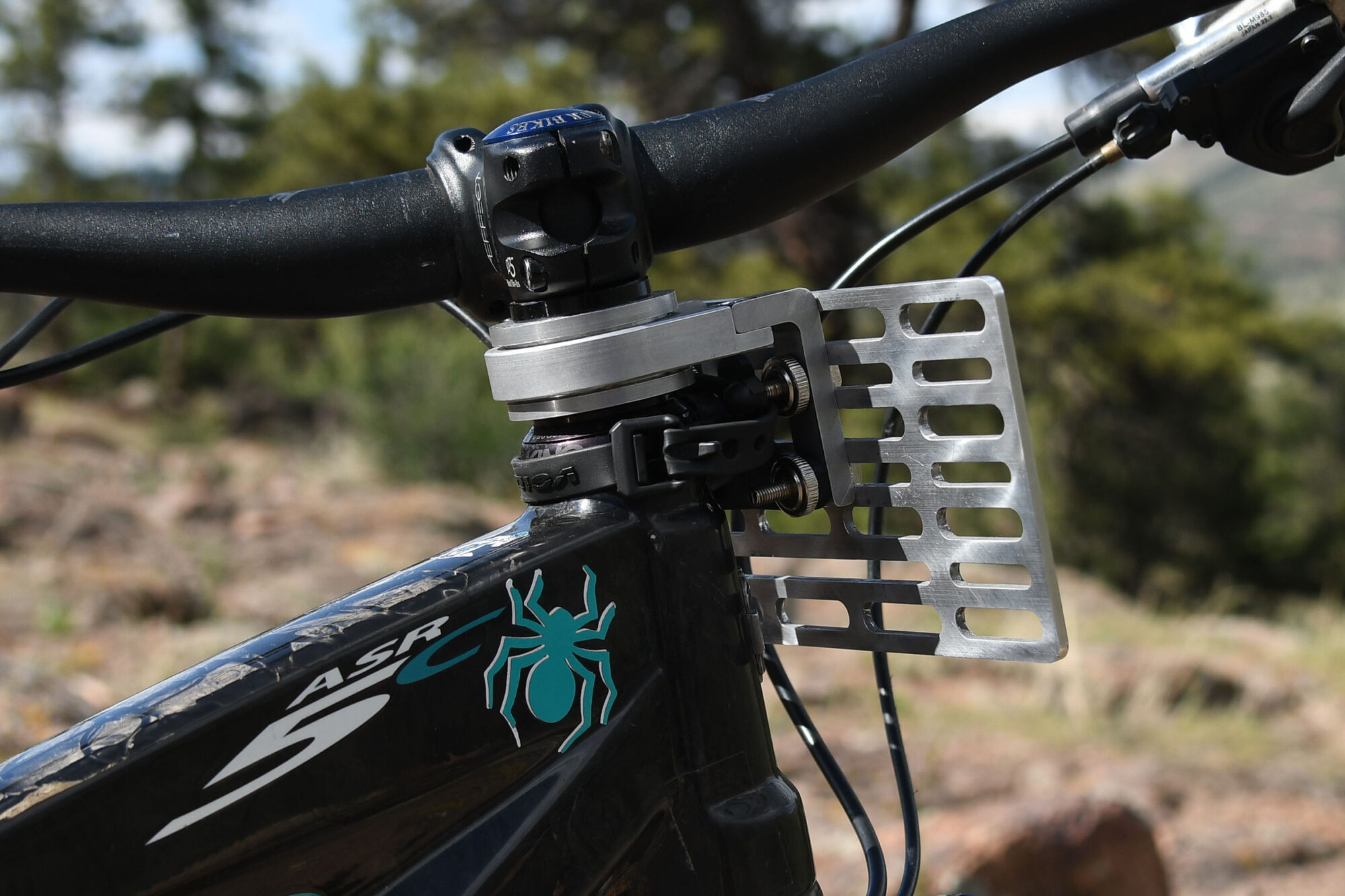
Orbiter Rack
- Type: Steerer-mount Cradle
- Load Rating: Not Specified
- Made of: 6061 T6 Aluminum
- Made in: Colorado, USA
CloseInspired by his time on the Grande Traversées du Jura (GTJ) in France and the European Divide Trail, Thorbin Atwell-Donaghey set out to design a handlebar cradle that would reduce the amount of front-end flop while navigating technical trails. His solution was to make a system that doesn’t rotate with the bars. The patent-pending Orbiter Rack is a unique steerer-tube-mounted cradle that sits on its own set of bearings between your stem and headset, allowing the handlebars to rotate independently from the rack—similar to how most cargo bikes are designed. With the load fixed relative to the handlebar, Thorbin claims the Orbiter Rack improves handling, frees up space on your bars for lights and other gadgets, and cleans up cable routing.
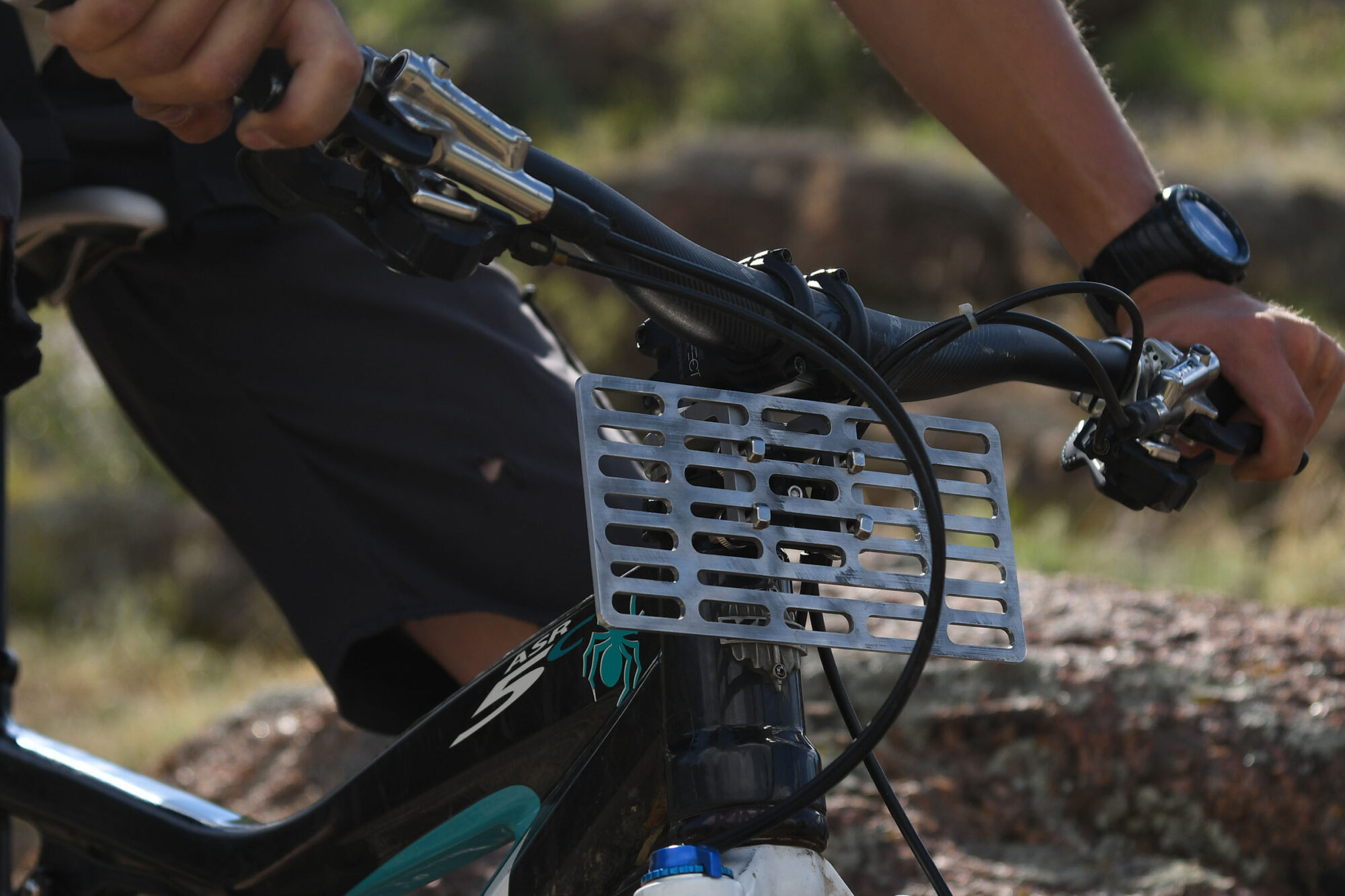
The Orbiter Rack appears to be universal, which should make it compatible with most bikes. All you need is a standard 1.125″/28.6mm steerer, a threadless headset, and at least 1″ of clearance between the bottom of your stem and the top of your headset. The Orbiter then takes the place of standard headset spacers and is fastened to the frame (to stop rotation) with a Voile strap alongside an integrated rubber foot. Alongside a machined aluminum T-brace, this disperses the load off the Orbiter bearings and onto the frame, prolonging their life and use. Two mounting arms accept an interesting tool-less detachment mechanism designed specifically to accept a machined 4×6″ PALS panel, offering 29 different potential bolt-on points for any type of accessory or bag, and should easily adapt into an existing setup. The slots on the PALS panel are positioned for MOLLE-equipped gear—an attachment standard that has been in use for decades in military, overland auto, and hunting applications.
The Orbiter and all of its components are machined in Colorado from 6061 T6 Aluminum sourced from a Colorado metal supplier. The entire setup weighs just 288 grams and costs $215 USD. Learn more at PedalStoke.com.
- Weight: 288 grams (10.2 oz)
- Price: $215
- Place of Manufacture: Colorado, USA
- Manufacturer's Details: Link
-
€30
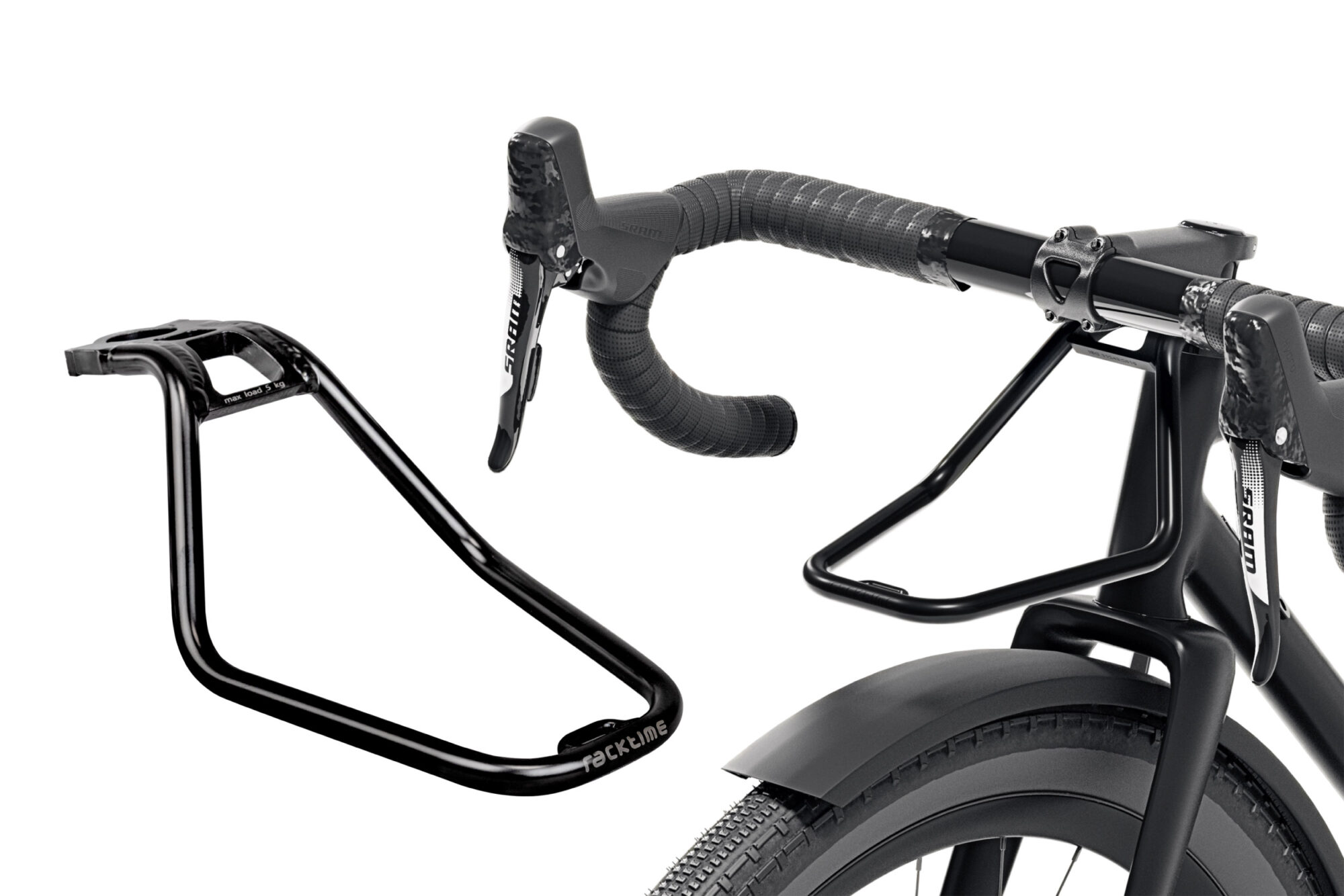
Racktime Viewit
- Type: Stem-mounted Cradle
- Load rating: 5 kg (11 lbs)
- Made of: Aluminum
- Made in: TBD
CloseThe Racktime VIEWIT is a minimalist, steerer-mounted front mini-rack made mostly from 12mm aluminum tubing that slides onto a 1 1/8″ (28.6mm) fork steerer to carry small loads—right where you can see them, hence the name. Racktime states that the front carrier can handle a load of up to five kilograms and mounts to aluminum or steel steerers (not carbon), and is ideal for carrying a sleep system or other luggage.
- Weight: 187 grams (6.6 oz)
- Price: €30
- Manufacturer's Details: Link
-
$125

Salsa Anything Cradle
- Type: Handlebar Cradle
- Load Rating: 3.6 kg (8 lbs)
- Made of: Nylon composite, 6061 aluminum
- Made in: TBD
CloseFirst released in 2016, the Salsa Anything Cradle was the first handlebar cradle to market that we know of. In 2020, it received a few small updates and was renamed the Salsa EXP Series Anything Cradle. This modular, bracket-mount handlebar system is designed to carry a roll bag out front without kinking cables, or to be used with Salsa’s Side-Load or Top-Load Dry Bags, securing the load with two included 30″ TPU rubber straps. The nylon 6/6 cradle and 6061-forged aluminum arms fit 35.0 mm bars or 31.8 mm with the shim.
The updates in 2020 was mainly centered around compatibility with 35.0 mm bars—it includes shims for 31.8 mm bars. In his first ride review, Miles confirmed that the shims work as intended and grip nicely on the bars, even over rough terrain.
- Weight: 469 grams (16.5 oz)
- Price: $125 (EXP Series)
- Manufacturer's Details: Link
-
$75
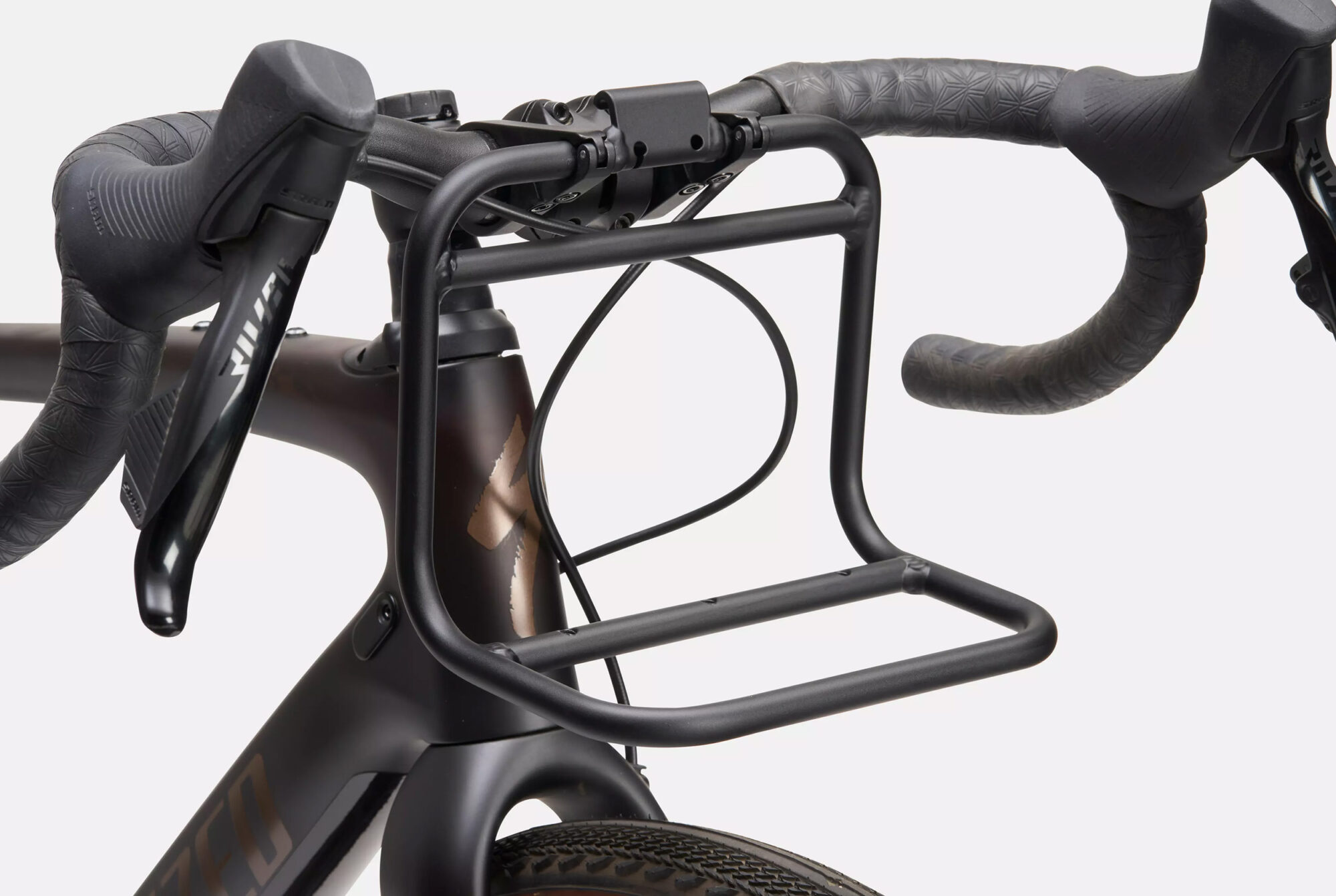
Specialized/Fjallraven Handlebar Rack
- Type: Handlebar Cradle
- Load rating: 5 kg (11 lbs)
- Made of: Aluminum
- Made in: TBD
CloseThe Specialized/Fjällräven Handlebar Rack is a lightweight aluminum mini-rack that mounts directly to 31.8 mm handlebars (flat or drop; although they specify that it’s not for “extreme downhill”). The rack measures 20 × 18 × 13 cm and is built to haul everything from parcels to dry bags or a tent, stabilized by an anti-rotation guyline, according to their description. Three under-rack accessory mounts let you add a light or camera, while lateral-adjust, replaceable clamps help it fit different cockpits. Doesn’t include webbing straps to secure the load.
- Weight: 330 grams (11.6 oz)
- Price: $75
- Manufacturer's Details: Link
Our Favorite Handlebar Cradles
Logan: Having tried seven of the options above, it was really difficult for me to pick a single favorite out of the bunch. I really like the Tailfin Bar Cage for it’s adjustable load placement, best-in-class attention to detail, and a complete set of features—strap-keepers, accessory mounts, etc—but I also like the fact that steerer-mount racks like the Rat King Cradle are rock solid and worry free when it comes to rotation or rotating your bars in the event of a big unexpected hit. Additionally, I’m super impressed with the MF Bedroll Harness. It’s incredibly light, perfectly simple, and very stable. It’s become the one I reach for most often for singletrack/mountain bike excursions.
Miles: I’ve had the pleasure of using two of the cradles in this Gear Index, and while I enjoyed the modularity of the Miss Grape ILCOSO, my top pick would be the Rogue Panda Blue Ridge. It’s incredibly lightweight, there isn’t a bunch of hardware to keep track of, and it feels simple, yet functional, with no unnecessary stuff going on.
Neil: I’ve been lucky enough to use a variety of handlebar cradles and harness systems over the past decade, and it’s incredible to see how much they’ve evolved. I started with the Salsa Anything Cradle, which felt pretty innovative at the time. The beauty of this category is that each new design has refined the idea just a little more. Every system I’ve tried has brought something unique to the table.
I’ve loved the multiple setups of the Miss Grape Ilcoso, and I’m a big fan of the dual-axis adjustability of the Tailfin Bar Cage—it makes it easy to fine-tune weight distribution and fit to the bike. But, if I had to pick just one, the Rogue Panda Blue Ridge is the one I’d go with. It doesn’t offer the same kind of adjustability as others, but I’ve found that fewer moving parts usually works better for me. I really appreciate its rigid nature, stable width, and impressively low overall weight.
We’ve tested as many handlebar cradles as we could find. However, there are probably more—like this 3d-printed DIY version—and chances are we glossed over a couple. Plus, there will likely be a few more models released soon. If you know of any we missed or have have a suggestion about a similar solution, please leave a note in the conversation below!
